|
The cultural relations between India and China can be
traced back to very early times. There are numerous references to China in Sanskrit
texts, but their chronology is sketchy. The Mahabharata refers to China several
times, including a reference to presents brought by the Chinese at the Rajasuya
Yajna of the Pandavas; also, the Arthasastra and the Manusmriti mention China.
According to French art historian, Rene Grousset, the name China comes from "an ancient"
Sanskrit name for the regions to the east, and not, as often supposed, from the
name of the state of Ch'in," the first dynasty established by Shih Huang Ti
in 221 B.C. The Sanskrit name Cina for China could have been derived from the
small state of that name in Chan-si in the northwest of China, which flourished
in the fourth century B.C. Scholars have pointed out that the Chinese word
for lion, shih, used long before the Chin dynasty, was derived from the Sanskrit
word, simha, and that the Greek word for China, Tzinista, used by some later
writers, appears to be derivative of the Sanskrit Chinasthana. According to
Terence Duke, martial arts went from India to China. Fighting
without weapons was a specialty of the ancient Kshatriya warriors of India. Both
Arnold Toynbee and Sir L. Wooley speak of a ready made culture coming to China.
That was the Vedic culture of India.
Until recently, India and China had coexisted
peacefully for over two thousand years. This amicable relationship may have been
nurtured by the close historical and religious ties of Buddhism, introduced to
China by Indian monks at a very early stage of their respective histories,
although there are fragmentary records of contacts anterior to the introduction
of Buddhism.
Gerolamo
Emilio Gerini (1860 -1913) has said: “During the three or four
centuries, preceding the Christian era, we find Indu
(Hindu) dynasties established by adventurers, claiming descent from the
Kshatriya potentates of northern India, ruling in upper Burma, in Siam and Laos,
in Yunnan and Tonkin, and even in most parts of southeastern China." The Chinese literature of the third century is full of
geographic and mythological elements derived from India. "I see no reason to doubt," comments Arthur Waley in his book, The
Way and its Power, "that the
'holy mountain-men' (sheng-hsien) described by Lieh Tzu are Indian rishi;
and when we read in Chuang Tzu of certain Taoists who practiced movements
very similar to the asanas of Hindu yoga, it is at least a possibility
that some knowledge of the yoga technique which these rishi used had also
drifted into China."



Bhaarat:
Teacher of China
Trade & Commerce
Contributions
Bhaarat's influence on Japan
Conclusion
Articles

Bhaarat:
Teacher of China
Hinduism and Buddhism, both have had profound effect on
religious and cultural life of China. Chinese early religion was based on nature
and had many things in common with Vedic Hinduism, with a pantheon of deities.
 "Never
before had China seen a religion so rich in imagery, so beautiful and
captivating in ritualism and so bold in cosmological and metaphysical
speculations. Like a poor beggar suddenly halting before a magnificent
storehouse of precious stones of dazzling brilliancy and splendor, China was
overwhelmed, baffled and overjoyed. She begged and borrowed freely from this
munificent giver. The first borrowings were chiefly from the religious life of
India, in which China's indebtedness to India can never be fully told." "Never
before had China seen a religion so rich in imagery, so beautiful and
captivating in ritualism and so bold in cosmological and metaphysical
speculations. Like a poor beggar suddenly halting before a magnificent
storehouse of precious stones of dazzling brilliancy and splendor, China was
overwhelmed, baffled and overjoyed. She begged and borrowed freely from this
munificent giver. The first borrowings were chiefly from the religious life of
India, in which China's indebtedness to India can never be fully told."
(source:
India
and World Civilization - By D. P. Singhal
p. 338).
The story of Sun Hou Tzu, the Monkey King, and
Hsuan Tsang. It is a vicarious and humorous
tale, an adventure story akin to the Hindu epic
of Ramayana, and like Ramayana, a moral tale of
the finer aspects of human endeavor which come to prevail over those of a less
worthy nature. The book ends with a dedication
to India: I dedicate this work to Buddha's pure
land. May it repay the kindness of patron and preceptor, may it mitigate the
sufferings of the lost and damned....'
(source: Eastern
Wisdom - By Michael Jordan p -134-151).
Arnold
Hermann Ludwig Heeren
(1760-1842) an Egyptologist and author of Historical
researches into the politics, intercourse, and trade of the Carthaginians,
Ethiopians, and Egyptians observes that:
"the name China is of Hindu origin and came to us
from India."
"M. de Guigues says that Magadha was known
to the Chinese by the name Mo-kiato, and its capital was recognized by both its
Hindu name Kusumpura, for which the Chinese wrote Kia-so-mo-pon-lo and
Pataliputra, out of which they made Patoli-tse by translating putra, which means
son in Sanskrit, into their own corresponding word, tse. Such translation of
names has thrown a Veil of obscurity over many a name of Hindu origin. Hindu
geography has suffered a great loss."
(source: Journal of the
Royal Asiatic Society Volume. V).
Lin Yutang
(1895-1976) author
of The Wisdom of China and India:
 "The contact with poets, forest saints and the
best wits of the land, the glimpse into the first awakening of Ancient India's
mind as it searched, at times childishly and naively, at times with a deep
intuition, but at all times earnestly and passionately, for the spiritual truths
and the meaning of existence - this experience must be highly stimulating to
anyone, particularly because the Hindu culture is so different and therefore so
much to offer." Not until we see the richness of the Hindu mind and its
essential spirituality can we understand India...." "The contact with poets, forest saints and the
best wits of the land, the glimpse into the first awakening of Ancient India's
mind as it searched, at times childishly and naively, at times with a deep
intuition, but at all times earnestly and passionately, for the spiritual truths
and the meaning of existence - this experience must be highly stimulating to
anyone, particularly because the Hindu culture is so different and therefore so
much to offer." Not until we see the richness of the Hindu mind and its
essential spirituality can we understand India...."
"India was China's teacher in religion and
imaginative literature, and the world's teacher in trignometry, quandratic
equations, grammar, phonetics, Arabian Nights, animal fables, chess, as well as
in philosophy, and that she inspired Boccaccio, Goethe, Herder, Schopenhauer,
Emerson, and probably also old Aesop."
(source: The
Wisdom of China and India - By Lin Yutang
p. 3-4).
Sir William Jones
(1746-1794) came to India as a judge of the Supreme Court at Calcutta. He
pioneered Sanskrit studies. His admiration for Indian thought and culture was
almost limitless. He says that the Chinese assert their Hindu origin."
(source: Annals
and Antiquities of Rajasthan; or the Central and Western Rajput States
- By James Tod Volume I, p. 35-57).
Amaury de Reincourt
(1918 - ) was
born in Orleans, France. He received his B.A. from the Sorbonne
and his M.A. from the University of Algiers. He is author of several books including The American empire and
The
Soul of India, he wrote: " The Chinese
travelers' description of life in India... reveals great admiration from all
concerned for the remarkable civilization displayed under their eyes."
"India sent missionaries, China
sending back pilgrims. It is a striking fact that in all relations between the
two civilizations, the Chinese were always the
recipient and the Indian the donor." "Indian influence prevailed
over the Chinese, and for evident reasons: an undoubted cultural superiority
owing to much greater philosophic and religious insight, and also to a far more
flexible script."
(source: The Soul of India – by
Amaury de
Riencourt p 141 and 161).
 
China
(Cinaratha) in the Epic of Mahabharata
It is well known that in the Mahabharata
the Cinas appear with the Kiratas among the
armies of king Bhagadatta of Pragjyotisa or Assam.
In the Sabhaparvan this king is described as surrounded by the Kiratas and the
Cinas. In the Bhismaparvan, the corps of Bhagadatta, consisting of the Kirtas
and the Cinas of yellow color, appeared like a forest of Karnikaras. It is
significant that the Kiratas represented all the people living to the east of
India in the estimation of the geographers of the Puranas. Even the dwellers of
the islands of the Eastern Archipelago were treated as Kiratas in the Epics. The
reference to their wealth of gold, silver, gems, sandal, aloewood, textiles and
fabrics clearly demonstrates their association with the regions included in
Suvarnadvipa. Thus, the connection of the Kiratas and Cinas is a sure indication
of the fact that the Indians came to know of the Chinese through the eastern
routes and considered them as an eastern people, having affinities to the Kiras,
who were the Indo-Mongoloids, inhabiting the Tibeto-Burman regions and the
Himalayan and East Indian territories, the word Kirata being a derivation from
kiranti or kirati, the name of a group of people in eastern Nepal.
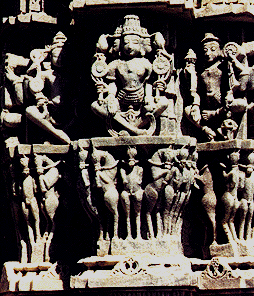 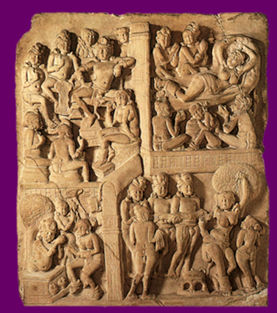
Watch
Scientific
verification of Vedic knowledge
(For
more refer to chapter on Greater
India: Suvarnabhumi and Sacred
Angkor).
***
In
early Indian literature China is invariably shown to be connected with India by
a land-route across the country of the Kiratas in the mountainous regions of the
north. In the Vanaparvan of the Mahabharata the Pandava brothers are
said to have crossed the country of the Cinas in course of their trek through
the Himalayan territory north of Badri and reached the realm of the Kirata king
Subahu. The Cinas are brought into intimate relationship with the Himalayan
people (Haimavatas) in the Sabhaparvan also. The land of the Haimavatas is
undoubtedly the Himavantappadesa of the Pali texts, which has been identified
with Tibet or Nepal. In the Sasanavamsa this region is stated to be Cinarattha.
Thus, it is clear that China was known to the Indians as lying across the
Himalayas and was accordingly included in the Himalayan territories. In the Nagarjunikonda
inscription of Virapurusdatta, China (Cina) is said to be lying in the Himalayas
beyond Cilata or Kirata. These references to the proximity of China to the
Himalayan regions, inhabited by the Kiratas, show that there were regular routes
through the Tibeto-Burman territories, along which the Indians could reach
China.
Some such land-route is implied in the remark of
the Harsacarita of Banabhatta that Arjuna conquered the Hemakuta region after
passing through Cina. Of course, the route across Central Asia is
perhaps alluded to in the itinerary of Carudatta from the Indus Delta to China
across the country of the Hunas and the Khasas, described in the Vasudevakindi,
and there is probably a reference to the sea-route, passing through Vanga,
Takkola and Suvarnadvipa, in the Milindapanho. But there is no doubt that in a
large number of ancient Indian texts China is mentioned near the eastern
Himalayan regions, through which regular routes, connecting this country with
India, passed from fairly early times. It was along these routes that India came
into contact with China for the first time and developed commercial relations
with her, that are referred to by Chan K’ien in the second century B.C.
In Yunnan there is a large
number of old pagodas. Some of them are the oldest and most beautiful in China.
Their cornices and corner decoration, showing rows of pitchers (mangala ghata),
betray unmistakable Indian influence. Many bricks of these pagodas bear Sanskrit
inscriptions, containing Buddhist mantras and formulae in a script, which is
identical with that current in Nalanda and Kamarupa in the 9th
century. The beautiful bronze statue of Avalokitesvara from the pagoda of
Ch’ung Sheng Ssu near Ta-li is an index to the high standard of culture and
craftsmanship attained by the Buddhists of Yunan.
In earlier times, the people of
the east, Magadha and Videha, were in contact with Yunan, as the traditions of
Purvavideha show. The two names, Purvavideha and Gandhara, seem to represent
these two successive eastern and western streams of Indian colonial and cultural
expansion in this region.
Henry
Rudolph Davies (1865 - ) says that Besides Buddhism, Shaivism was
also popular in Yunan as is manifest from the prevalence of the cult of Mahakala
there. This ancient Indian colony in the south of China was the cradle of
Sino-Indian cultural relationship for a long time.
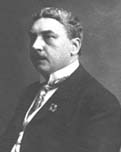 It
was an important outpost of Indian cultural expansion along the eastern
land-routes, which Colonel Gerolamo
Emilio Gerini (1860 -1913) author of Researches
on Ptolemy's geography of eastern Asia (further India and Indo-Malay archipelago
p. 122 -124 has described as
follows: It
was an important outpost of Indian cultural expansion along the eastern
land-routes, which Colonel Gerolamo
Emilio Gerini (1860 -1913) author of Researches
on Ptolemy's geography of eastern Asia (further India and Indo-Malay archipelago
p. 122 -124 has described as
follows:
“During the three or four
centuries, preceding the Christian era, we find Indu
(Hindu) dynasties established by adventurers, claiming descent from the
Kshatriya potentates of northern India, ruling in upper Burma, in Siam and Laos,
in Yunnan and Tonkin, and even in most parts of southeastern China.
From the Brahmaputra and Manipur to the Tonkin Gulf we can trace a continuous
string of petty states, ruled by those scion of the Kshatriya
race, using the Sanskrit or Pali language in official documents or inscriptions;
building temples and other monuments after the Indu (Hindu) style and employing
Brahmana priests for the propitiatory ceremonies, connected with the
court and state. Among such Indu (Hindu) monarchies (Theinni) in Burma, of Muang
Hang, C’hieng Rung, Muang Khwan and Dasarna (Luang P’hrah Bang) in the Lau
country; and of Agranagara (Hanoi) and Campa in Tonkin and Annan.”
“The names of peoples and
cities, recorded by Ptolemy in that region,
however few and imperfectly preserved, are sufficiently significant to prove the
presence of the Indu (Hindu) ruling and civilizing element in these countries,
undoubtedly not so barbarous as the Chinese would make them appear.”
“It is evident through the
medium of those barbarians that China received part of
her civilization through India.”
Among these colonies Tagong and
upper Pugan were called Mayura; Prome was Sriksetra; Sen-wi (Theinni) was
Sivirastra; Muang Hang, Chieng Rung and Muang Khwan were the three divisions of
Ching Rung kingdom, which the prince of Yong, named Sunandakumara, united under
Mahiyagananagara; Luang P’hrah Bang was Dasarna; Hanoi was Agranagara; Tagaung
was Brahmadesa (P’o-;o-men), where a Sanskrit inscription, dated in Gupta era
108 – 426 A.D. refers to Hastinapura, situated in that country; and, of
course, Yunana was Purvavideha or Gandhara. Thus, from Arakan, where the
Mrohaung inscriptions attest the efflorescence of Indian culture, language and
literature, to Yunnan, whose history we have traced above, Indian culture made a
triumphant advance in ancient times.
(source: Yün-nan;
the link between India and the Yangtze – by Henry Rudolph Davies
Cambridge University press 1909 an India
and The World - By Buddha Prakash p. 141-150).

India was known as
T'ien-chu to the Chinese.
***
China, like Southeast Asia too, was colonized to
some extent by the ancient Hindus. The religion and culture of China are
undoubtedly of Hindu origin. According to the Hindu theory of emigration,
Kshatriyas from India went and established colonies in China. India was known as
T'ien-chu
to the Chinese.
Colonel
James Tod (1782-1835) author of Annals
and Antiquities of Rajasthan: or the Central and Western Rajput States of India
has written:
"The genealogies of China and Tartary
declare themselves to be the descendents of "Awar," son of the Hindu
King "Pururawa."
According to the traditions noted in the Schuking,
the ancestors of the Chinese, conducted by Fohe, come to the plains of China
2,900 years before Christ, from the high mountains Land which lies to the west
of that country. This shows that the settlers into China were originally
inhabitants of Kashmir, Ladakh, Little Tibet and the Punjab, which were parts of
Ancient India.
Kakuzo
Okakura, speaking of the missionary activity of Indian Buddhists in
China, says that at one time in the single province of Lo-yang there were more
than 3,000 Indian monks and 10,000 Indian families to impress their national
religion and art on Chinese soil.
(source: The
Ideals of the East With Special Reference to the Art of Japan - By Kakuzo
Okakura p. 113).
 Hu
Shih,
(1891-1962), Chinese philosopher in Republican China. He was ambassador to the
U.S. (1938-42) and chancellor of Peking University (1946-48). He said: Hu
Shih,
(1891-1962), Chinese philosopher in Republican China. He was ambassador to the
U.S. (1938-42) and chancellor of Peking University (1946-48). He said:
"India conquered and dominated China culturally for two thousand
years without ever
having to send a single soldier across her border."
Court Bjornstjerna
(1779-1847) author of The
Theogony of the Hindoos with their systems of Philosophy and Cosmogony says: " what may be said with certainty is that the religion of China came
from India."
Chinese authors, too, according to Mountstuart
Elphinstone (1779-1859) noted, Indian ambassadors to the court of
China.
The Mahabharata refers to China several
times, including a reference to presents brought by the Chinese at the Rajasuya
Yajna of the Pandavas; also, the Arthasastra and the Manusmriti mention China.
According to Rene Grousset (1885-1952)
French art historian
in his book Rise
and Splendour of Chinese Empire ASIN 0520005252 p.
79:
"the name China comes from "an ancient"
Sanskrit name for the regions to the east, and not, as often supposed, from the
name of the state of Ch'in," the first dynasty established by Shih Huang Ti
in 221 B.C.

Brahma - Chinese version.
(image source: Our Heritage and Its Significance - By S. R.
Sharma).
***
The Sanskrit name Cina for China could have been derived from the
small state of that name in Chan-si in the northwest of China, which flourished
in the fourth century B.C. Scholars have pointed out that the Chinese word
for lion, shih, used long before the Chin dynasty, was derived from the Sanskrit
word, simha, and that the Greek word for China, Tzinista, used by some later
writers, appears to be derivative of the Sanskrit Chinasthana. The Chinese literature of the third century is full of
geographic and mythological elements derived from India.
" I see no reason to doubt," comments Arthur
Waley in his book, The
Way and its Power, "that the
'holy mountain-men' (sheng-hsien) described by Lieh Tzu are Indian rishi;
and when we read in Chuang Tzu of certain Taoists who practiced movements
very similar to the asanas of Hindu yoga, it is at least a possibility
that some knowledge of the yoga technique which these rishi used had also
drifted into China."
Both Sir L. Wooley and
British historian Arnold Toynbee speak
of an earlier ready-made culture coming to China. They were right. That was the
Vedic Hindu culture from India with its Sanskrit language and sacred
scripts. The contemporary astronomical expertise of the Chinese, as
evidenced by their records of eclipses; the philosophy of the Chinese their
statecraft, all point to a Vedic origin. That is why from the earliest times we
find Chinese travelers visiting India very often to renew their educational and
spiritual links.
Author Kenneth
Ch'en has said:
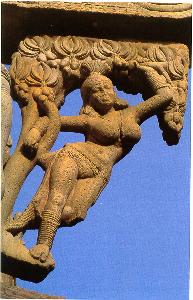 "Neo-Confucianism was stimulated in its
development by a number of Buddhist ideas. Certain features of Taoism, such as
its canon and pantheon, was taken over from Buddhism. Works and phrases in the
Chinese language owe their origin to terms introduced by Buddhism. Chinese
language owe their origin to terms introduced by Buddhism, while in
astronomical, calendrical, and medical studies the Chinese benefited from
information introduced by Indian Buddhist monks. Finally, and most important of
all, the religious life of the Chinese was affected profoundly by the doctrines
and practices, pantheon and ceremonies brought in by the Indian
religion." "Neo-Confucianism was stimulated in its
development by a number of Buddhist ideas. Certain features of Taoism, such as
its canon and pantheon, was taken over from Buddhism. Works and phrases in the
Chinese language owe their origin to terms introduced by Buddhism. Chinese
language owe their origin to terms introduced by Buddhism, while in
astronomical, calendrical, and medical studies the Chinese benefited from
information introduced by Indian Buddhist monks. Finally, and most important of
all, the religious life of the Chinese was affected profoundly by the doctrines
and practices, pantheon and ceremonies brought in by the Indian
religion."
(source: Buddhism
in China - By Kenneth Ch'en ISBN 0691000158 p. 3).
How China was part of the Indian Vedic empire
is explained by Professor G. Phillips on
page 585 in the 1965 edition of the Journal of
the Royal Asiatic Society. He remarks,
"The maritime intercourse of India and China dates from a much earlier
period, from about 680 B.C. when the sea traders of the Indian Ocean whose
chiefs were Hindus founded a colony called Lang-ga, after the Indian named Lanka
of Ceylon, about the present gulf of Kias-Tehoa, where they arrived in vessels
having prows shaped like the heads of birds or animals after the pattern
specified in the Yukti Kalpataru
(an ancient Sanskrit technological text) and exemplified in the ships and boats
of old Indian arts."
Chinese
historian Dr. Li-Chi also discovered an astonishing resemblance between the
Chinese clay pottery and the pottery discovered at Mohenja daro on the Indian
continent. Yuag Xianji,
member of the Chinese People's Political Consultative Conference, speaking at
the C. P. Ramaswamy Aiyar Foundation, Madras, March 27 1984 said,
" Recent
discoveries of ruins of Hindu temples in Southeast China provided further
evidence of Hinduism in China. Both Buddhism and Hinduism were patronized by the
rulers. In the 6th century A.D. the royal family was Hindu for two generations.
The following Tang dynasty (7th to the 9th century A.D.) also patronized both
Hinduism and Buddhism because the latter was but a branch of Hinduism. Religious
wars were unknown in ancient China. There was extensive maritime trade and
religious exchanges between India and China at this period (Ad 1-600) and
the massive expansion of Indian influence into southern China through Jih-nan
and Chiao-chih, in what is now northern Vietnam.
Albert Etienne Terrien de
Lacouperie, author of Western
Origins of Chinese Civilization states that the maritime intercourse
of India with China dates from about 680 B.C. when the sea traders of the Indian
ocean" whose "Chiefs were Hindus" founded a colony, called Lang-ga,
after the Indian name Lanka, about the present gulf of Kiaotchoa....And
throughout this period the monopoly of the sea borne trade of China was in their
hands."
In the second century A.D., Indians from the
Sindhu during the time of Rudradaman, the Khshatrapa Satrap of Kattiawad, took
presents by sea to China.
(source: Milinda Panha -
Vide p. 127-327). Refer to
Marco Polo’s epic journey to China was a big con –
Team Folks
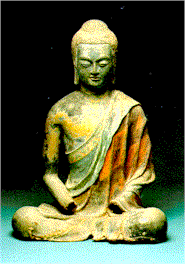 The sea route from India and China through the
port of Tamraliptis was under the special protection of the Indian kings. When
the Chinese pilgrim, Hiuen-Tsiang, wanted to
return to China in A.D. 645, Bhashkarvarman the king of Kamrup (Assam) and a
vassal of King Harsha, told him: "But I know not, if you prefer to go, by
what route you propose to return; if you select the southern sea route, then I
will send official attendants to accompany you." Itsing
sailed from China for India in A.D. 671 and returned to China twenty-four years
later by the sea route from Tamralipiti. The sea route from India and China through the
port of Tamraliptis was under the special protection of the Indian kings. When
the Chinese pilgrim, Hiuen-Tsiang, wanted to
return to China in A.D. 645, Bhashkarvarman the king of Kamrup (Assam) and a
vassal of King Harsha, told him: "But I know not, if you prefer to go, by
what route you propose to return; if you select the southern sea route, then I
will send official attendants to accompany you." Itsing
sailed from China for India in A.D. 671 and returned to China twenty-four years
later by the sea route from Tamralipiti.
Through
its compassionate Buddhas and Bodhisattvas, and its promise of salvation to all
alike, its emphasis on piety, meditation, its attractive rituals and festivals,
its universality and its tolerance, "the religious life of the Chinese has
been enriched, deepened, broadened, and made more meaningful in terms of human
sympathy, love, and compassion for all living creatures." The
doctrine
of karma brought spiritual consolation to
innumerable people. The concept of karma is to be found in all types of Chinese
literature from poetry to popular tales.
India never imposed her ideas or culture on any nation by military force, not
even on the small countries in her neighborhood, and in the case of China, it
would have been virtually impossible to do so since China has been the more
powerful of the two. So the expansion of Indian culture into China is a monument
to human understanding and cultural co-operation - the outcome of a voluntary
quest for learning. While China almost completely suppressed other foreign
religions, such as Zoranstrianism, Nestorian Christianity, and to some extent
Manichaeanism, she could not uproot Buddhism. At times, Buddhism was persecuted,
but for two thousand years it continued to Indianize Chinese life even after it
had ceased to be a vital force in the homeland and long after it had lost its
place as the dominant religion of China. In fact, Indianization became
more powerful and effective after it was thought that Buddhism had been killed
in China.
The introduction of Buddhism is one of the most
important events in Chinese history, and since its inception it has been a major
factor in Chinese civilization. The Chinese have
freely acknowledged their debt to India, often referring to her as the
"Teacher of China," and Chinese Buddhists have pictured India as a
Western Paradise, Sukhavati. That Chinese
philosophy blossomed afresh after the impact of Buddhism indicates both a
response to and a borrowing of Indian ideas. The advent of Buddhism meant for
many Chinese a new way of life, and for all Chinese, a means of reassessing
their traditional beliefs. A new conception of the universe developed, and the
entire Chinese way of life was slowly but surely altered. The change was so
gradual and so universal that few people realized it was happening.
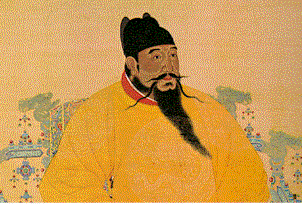 The Chinese Quietists practiced a form of
self-hypnosis which has an indisputably close resemblance to Indian
Yoga.
The Chinese Taoist philosopher Liu-An (Huai-nan-tzu)
who died in 122 B. C, makes
use "of a cosmology in his book which is clearly of Buddhist
inspiration." The Chinese Quietists practiced a form of
self-hypnosis which has an indisputably close resemblance to Indian
Yoga.
The Chinese Taoist philosopher Liu-An (Huai-nan-tzu)
who died in 122 B. C, makes
use "of a cosmology in his book which is clearly of Buddhist
inspiration."
The
first mention of India to be found in Chinese records is in connection with the
mission to Ta-hsia (Bacteriana) of a talented and courageous Chinese envoy, Chang
Chien (Kien), about 138 B.C. Fourteen years
later, having escaped after ten years as a captive of the Huns, he returned home
and in his report to the Chinese Emperor he referred to the country of Shen-tu
(India) to the southeast of the Yueh-chih (Jou-Chih) country. There are other
traditional stories suggestive of earlier links, but Chang Chien's reference to
Indian trade with the southwestern districts of China along the overland route
corresponding to the modern Yunnan road indicates the existence of some sort of
commercial relations well before the second century B.C. The find of
Chinese coins at Mysore, dated 138 B.C. suggests maritime relations between
India and China existed in the second century B.C. Passages in a Chinese text
vaguely refer to Chinese trade relations with countries in the China Sea and
Indian Ocean, such as Huang-che (Kanchi or a place in the Ganges delta), as well
as to the exchange of diplomatic missions.
Top of Page

Trade & Commerce
The chronicle 'Sung-chu'
states that all the precious things of land and water came from India. Gems
made of rhinoceros' horns and king-fishers' stones, serpent pearls and asbestos
cloth, they are being innumerable varieties of these curiosities, were imported
into China from India. According to the Chin-hsi-yu-chiu-t'
u rare stone came to China from the countries of Chi-pin (Gandhara or Kashmir).
Moreover, po-tie ( a fine textile, probably muslin) was produced in India; and
as early as A.D. 430 Indian po-tie was sent to China from Ho-lo-tan or Java. In
A.D. 519, King Jayavarman of Fu-nan (Kamboja/Cambodia) offered saffron with
storax and other aromatics to the Chinese court. Laufer also suggests that in
the sixth century saffron was traded from India to Cambodia. In the T'ang
Annals, India in her trade with Cambodia and the interior orient,
"export to those countries diamonds, sandalwood and saffron." India
was a good market for Chinese silk. Kalidasa
mentions this silk fabric (Chinamsuka) as one of the most fashionable textiles
among the richer sections of society. Silk and silk-products were also much
demanded luxury articles even in the reign of Harshavardhana. The countries
lying on the route from Kashgar (India) to China, were collectively called by
historians and geographers as 'Ser-India', first imbibed Indian culture and then
developed into important trade centers.
(source:
Cultural
Heritage of Ancient India - By Sachindra Kumar Maity p.119-124).
For more information refer to chapter on Suvarnabhumi
and Seafaring in Ancient India).
There can be little dispute that trade was the main
motivation for these early contacts. This is supported by finds of beads and
pottery, in addition to specific references in historical texts. By the early
centuries of the Christian era, Sino-Indian trade appears to have assumed
considerable proportions. Chinese silk, Chinamsuka, and later porcelain
were highly prized in India, and Indian textiles were sold in southwest China.
The similarity between the Chinese and Indian words for vermilion and bamboo,
ch'in-tung and ki-chok, and sindura and kichaka, also indicates commercial
links. At least by the fifth century, India was exporting to China wootz steel
(wootz
from the Indian Kanarese word ukku), which was produced by fusing magnetic iron
by carbonaceous matter.
 With goods came ideas. It has often been contended that
merchants were not likely to have been interested in philosophy or capable of
the exchange of ideas. This is an erroneous belief which disregards historical
evidence and, as Arthur Waley points out, is
"derived
from a false analogy between East and West. It is quite true that Marco polo 'songeait
surtout a son negoce'. But
the same can hardly be said of Indian or Chinese merchants.
Buddhist legend, for example, teems with merchants reputedly capable of
discussing metaphysical questions; and in China Lu Puwei, compiler of
philosophical encyclopedia Lu Shih Ch'un Chiu, was himself a merchant. Legend
even makes a merchant of Kuan Chung; which at any rate shows that philosophy and
trade were not currently supposed to be incompatible." With goods came ideas. It has often been contended that
merchants were not likely to have been interested in philosophy or capable of
the exchange of ideas. This is an erroneous belief which disregards historical
evidence and, as Arthur Waley points out, is
"derived
from a false analogy between East and West. It is quite true that Marco polo 'songeait
surtout a son negoce'. But
the same can hardly be said of Indian or Chinese merchants.
Buddhist legend, for example, teems with merchants reputedly capable of
discussing metaphysical questions; and in China Lu Puwei, compiler of
philosophical encyclopedia Lu Shih Ch'un Chiu, was himself a merchant. Legend
even makes a merchant of Kuan Chung; which at any rate shows that philosophy and
trade were not currently supposed to be incompatible."
India had contact with China from the early
period through three routes. One was through the Central Asian region, the
second was through Yunan and Burma. The third was by sea to the South Indian
ports. The Arthasastra, the Mahabharata, and the Manu-Smriti show knowledge of
China. Through all these routes trade and Hindu culture passed to China. Indian
arts and sciences were carried to China along with Buddhism. Images, rock-cut
caves and the fresco paintings show distinctly Indian influence on the Chinese
art. Indian astronomy, mathematics and medicine were spread in China by the
scholars who visited it. Several Sanskrit works on these sciences were
translated into Chinese.
Chushu-King, a Chinese monk started for India in
260 A.D. But he returned from Khotan. Fa-hien, the first Chinese pilgrim to
India stayed here during the Gupta period for some years. Che-mong another monk
accompanied by a few others spent 20 years (404-424) in the pilgrimage of India.
Hieun Tsang and I-Tsing during the 7th century are well-known. On his return to
China, Hiuen Tsang was given a great national welcome by his emperor and the
people as well.
(source: Ancient Indian
History and Culture - By Chidambara Kulkarni p.233 -234).
Land and Sea Routes
 The art of shipbuilding and navigation in India and China at the time was
sufficiently advanced for oceanic crossings. Indian ships operating between Indian and
South-east Asian ports were large and well equipped to sail cross the Bay of Bengal. When
the Chinese Buddhist scholar, Fa-hsien,
returned from India, his ship carried a crew of more than two hundred
persons and did not sail along the coasts but directly across the ocean. Such ships
were larger than those Columbus used to negotiate the Atlantic a thousand years later. Uttaraptha
was the Sanskrit name of the ancient highway which connected India with China,
Russia and Persia (Iran).
The art of shipbuilding and navigation in India and China at the time was
sufficiently advanced for oceanic crossings. Indian ships operating between Indian and
South-east Asian ports were large and well equipped to sail cross the Bay of Bengal. When
the Chinese Buddhist scholar, Fa-hsien,
returned from India, his ship carried a crew of more than two hundred
persons and did not sail along the coasts but directly across the ocean. Such ships
were larger than those Columbus used to negotiate the Atlantic a thousand years later. Uttaraptha
was the Sanskrit name of the ancient highway which connected India with China,
Russia and Persia (Iran).
The trade routes between China and India, by both land
and sea, were long and perilous, often requiring considerably more than two
years to negotiate. The overland routes were much older and more often used, but
the sea routes gained popularity with progress in shipbuilding and seamanship.
Formidable and frightening as the physiography of the land routes was, the
traffic through the passes and along the circuitous routes around the mountains
was fairly vigorous.
According to the work of mediaeval times,
Yukti Kalpataru, which gives a fund of information
about shipbuilding, India built large vessels from 200 B.C. to the close of the sixteenth
century. A Chinese chronicler mentions ships of Southern Asia that could carry as many as
one thousand persons, and were manned mainly by Malayan crews.
Long before
the northwestern routes were opened about the second century B.C. and long
before the development of these Indianized states, there were two other routes
from India to China. One of these began at Pataliputra (modern Patna), passed
through Assam (Kamarupa of old) and Upper Burma near Bhamo, and proceeded over
the mountains and across the river valleys to Yunnanfu (Kunming), the main city
of the southern province of China. The other route lay through Nepal and Tibet,
was developed much later in the middle of the seventh century when Tibet had
accepted Buddhism.
 In addition to land routes, there was an important sea
link between India and China through Southeast Asia. During the course of the
first few centuries of the Christian era, a number of Indianized states had been
founded all over Southeast Asia. Both cultures met in this region, and the
Indianized states served as an intermediary stave for the further transmission
of Indian culture and Buddhism to China. In addition to land routes, there was an important sea
link between India and China through Southeast Asia. During the course of the
first few centuries of the Christian era, a number of Indianized states had been
founded all over Southeast Asia. Both cultures met in this region, and the
Indianized states served as an intermediary stave for the further transmission
of Indian culture and Buddhism to China.
Ancient Greek geographers knew of Southeast Asia and
China (Thinae) were accessible by sea. Ptolemy mentions an important but
unidentified Chinese port on the Tonkinese coast. Ports on the western coast of
India were Bharukaccha (Broach); Surparka (Sopara); Kalyana; on the Bay of
Bengal at the mouth of the Kaveripattam (Puhar); and at the mouth of the Ganges,
Tamaralipti (Tamluk). At least two of these ports on the Bay of Bengal -
Kaveripattam and Tamaralipti - were known to the Greek sailors as Khaberos and
Tamalitis. At first Indian ships sailed to Tonkin (Kiao-Che) which was the
principal port of China, Tonkin being a Chinese protectorate. Later all foreign
ships were required to sail to Canton in China proper. Canton became a
prosperous port and from the seventh century onward the most important landing
place for Buddhist monks arriving from India. Generally Chinese monks set out
for the famous centers of learning in India, like the University of Taxila, and
Nalanda.
India
had census enumeration earlier than China, since such enumeration is mentioned
in Kautilya’s Arthasastra. China had its first census in 2 A.D.
Top of Page
Contributions
Mathematics:
The Chinese were familiar with Indian mathematics,
and, in fact, continued to study it long after the period of intellectual
intercourse between India and China had ceased."
(source: Cited in Sarkar,
Hindu Achievements in Exact Science, p. 14).
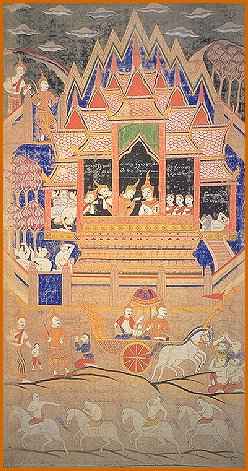 Literature: The
great literary activity of the Buddhist scholars naturally had a permanent
influence on Chinese literature, one of the oldest in the world. In a recent
study a Chinese scholar Lai Ming,
says that a significant feature in the development of Chinese literature has
been the "the immense influence of Buddhist literature on the development
of every sphere of Chinese literature since the Eastern Chin period (317
A.D.)." The Buddhist sutras were written in combined prose and rhymed
verse, a literary form unknown in China at the time. The Chinese language when
pronounced in the Sanskrit polyphonic manner was likely to sound hurried and
abrupt, and to chant the Sanskrit verses in monophthongal Chinese prolonged the
verse so much the rhymes were lost. Hence, to make the Chinese sutras pleasant
to listen to, the Chinese language had to be modified to accommodate Sanskrit
sounds. Consequently, in 489, Yung Ming, Prince
of Ching Ling, convened a conference of
Buddhist monks at his capital to differentiate between, and define the tones of,
the Chinese language for reading Buddhist sutras and for changing the verses. A
new theory emerged called the Theory of Four Tones. The introduction into China
of highly imaginative literature such as the Mahayana sutras and the Indian
epics, like Ramayana and Mahabharata,
infused into Chinese literature the quality of imagination which had been
hitherto lacking. Taoist literature, such as the book Chuang-tzu, did perhaps
show some quality of imaginative power, but on the whole Chinese literature,
especially Confucianist, was narrow, formal, restricted, and
unimaginative. Literature: The
great literary activity of the Buddhist scholars naturally had a permanent
influence on Chinese literature, one of the oldest in the world. In a recent
study a Chinese scholar Lai Ming,
says that a significant feature in the development of Chinese literature has
been the "the immense influence of Buddhist literature on the development
of every sphere of Chinese literature since the Eastern Chin period (317
A.D.)." The Buddhist sutras were written in combined prose and rhymed
verse, a literary form unknown in China at the time. The Chinese language when
pronounced in the Sanskrit polyphonic manner was likely to sound hurried and
abrupt, and to chant the Sanskrit verses in monophthongal Chinese prolonged the
verse so much the rhymes were lost. Hence, to make the Chinese sutras pleasant
to listen to, the Chinese language had to be modified to accommodate Sanskrit
sounds. Consequently, in 489, Yung Ming, Prince
of Ching Ling, convened a conference of
Buddhist monks at his capital to differentiate between, and define the tones of,
the Chinese language for reading Buddhist sutras and for changing the verses. A
new theory emerged called the Theory of Four Tones. The introduction into China
of highly imaginative literature such as the Mahayana sutras and the Indian
epics, like Ramayana and Mahabharata,
infused into Chinese literature the quality of imagination which had been
hitherto lacking. Taoist literature, such as the book Chuang-tzu, did perhaps
show some quality of imaginative power, but on the whole Chinese literature,
especially Confucianist, was narrow, formal, restricted, and
unimaginative.
Mythology: The
Chinese sense of realism was so intense that there was hardly any mythology in
ancient China, and they have produced few fairy tales of their own. Most of
their finest fairy tales were originally brought to China by Indian monks in the
first millennium. The Buddhists used them to make their sermons more agreeable
and lucid. The tales eventually spread throughout the country, assuming a
Chinese appearance conformable to their new environment. For example, the
stories of Chinese plays such as A Play of Thunder-Peak, A Dream of
Butterfly, and A Record of Southern Trees were of Buddhist
origin.
 Drama: Chinese
drama assimilated Indian features in three stages. First, the story, characters,
and technique were all borrowed from India; later, Indian technique gave way to
Chinese; and finally, the story was modified and the characters became Chinese
also. There are many dimensions to Chinese drama, and it is not easy to place
them accurately in history. However, the twelfth century provides the
first-known record of the performance of a play, a Buddhist miracle-play called
Mu-lien Rescues his Mother based on an episode in the Indian
epic, the Mahabharata. The subject matter of
the Buddhist adaptation of the story, in which Maudgalyayana (Mu-lien in
Chinese) rescues the mother from hell, occurs in a Tun-huang pien wen.
Significantly, the play was first performed at the Northern Sung capital by
professionals before a religious festival. Drama: Chinese
drama assimilated Indian features in three stages. First, the story, characters,
and technique were all borrowed from India; later, Indian technique gave way to
Chinese; and finally, the story was modified and the characters became Chinese
also. There are many dimensions to Chinese drama, and it is not easy to place
them accurately in history. However, the twelfth century provides the
first-known record of the performance of a play, a Buddhist miracle-play called
Mu-lien Rescues his Mother based on an episode in the Indian
epic, the Mahabharata. The subject matter of
the Buddhist adaptation of the story, in which Maudgalyayana (Mu-lien in
Chinese) rescues the mother from hell, occurs in a Tun-huang pien wen.
Significantly, the play was first performed at the Northern Sung capital by
professionals before a religious festival.
***
Amartya
Sen Nobel
Prize winner writes in the Times of India:
"It
is not often realized "that even such a central term in Chinese culture as
Mandarin is derived from a Sanskrit word, namely Mantri
which went from India to China via Malaya."
Chinese translation - the first printed book in
the world was the Chinese translation by Kumarajiva (a half Indian half Turkish
scholar) of a Buddhist Sanskrit text, Vajrachchedikaprajnyaparamita
(source: India,
according to Amartya Sen - by M.V.
Kamath
Publication:
Afternoon Despatch & Courier).***
 Grammar:
Phrases
and words coined by Buddhist scholars enriched the Chinese vocabulary by more
than thirty-five thousand words. As the assimilation was spread over a long
period of time, the Chinese accepted these words as a matter of course without
even suspecting their foreign origin. Even today words of Buddhist origin are
widely used in China from the folklore of peasants to the formal language of the
intelligentsia. For example, poli for glass in the name of many precious
and semi-precious stones is of Sanskrit origin.
Cha-na, an instant, from kshana; t'a, pagoda, from stupa;
mo-li, jasmine, from mallika, and terms for many trees and plants
are amongst the many thousands of Chinese words of Indian origin. Indian grammar
also undoubtedly stimulated Chinese philological study. Chinese script consists
of numerous symbols, which in their earliest stage were chiefly pictographic and
ideographic. Grammar:
Phrases
and words coined by Buddhist scholars enriched the Chinese vocabulary by more
than thirty-five thousand words. As the assimilation was spread over a long
period of time, the Chinese accepted these words as a matter of course without
even suspecting their foreign origin. Even today words of Buddhist origin are
widely used in China from the folklore of peasants to the formal language of the
intelligentsia. For example, poli for glass in the name of many precious
and semi-precious stones is of Sanskrit origin.
Cha-na, an instant, from kshana; t'a, pagoda, from stupa;
mo-li, jasmine, from mallika, and terms for many trees and plants
are amongst the many thousands of Chinese words of Indian origin. Indian grammar
also undoubtedly stimulated Chinese philological study. Chinese script consists
of numerous symbols, which in their earliest stage were chiefly pictographic and
ideographic.
The word used in the old Sanskrit for
the Chinese Emperor is deva-putra,
which is an exact translation of ' Son of Heaven.'
I-tsing,
a famous pilgrim, himself a fine
scholar of Sanskrit, praises the language and says it is respected in far
countries in the north and south. ..'How much
more then should people of the divine land (China), as well as the celestial
store house (India), teach the real rules of the language.'
Jawaharlal Nehru has
commented:
"Sanskrit scholarship must have been fairly widespread in China. It is
interesting to find that some Chinese scholars tried to introduce Sanskrit
phonetics into the Chinese language. A well-known example of this is that of the
monk Shon Wen, who lived at the time of the Tang dynasty. He tried to develop an
alphabetical system along these lines in Chinese."
(source: The Discovery
of India - By Jawaharlal Nehru p.
197-198).
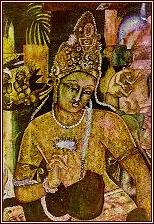 Art: Indian art
also reached China, mainly through Central Asia, although some works of Buddhist
art came by sea. Monks and their retinues, and traders brought Buddha
statues, models of Hindu temples, and other objects of art to China. Fa-hsien
made drawings of images whilst at Tamralipiti. Hsuan-tsang
returned with several golden and sandalwood figures of the Buddha; and Hui-lun
with a model of the Nalanda Mahavihara. Wang
Huan-ts'e, who went to India several times,
collected many drawings of Buddhist images, including a copy of the Buddha image
at Bodhgaya; this was deposited at the Imperial palace and served as a model of
the image in Ko-ngai-see temple. The most famous icon of East Asian Buddhism
know as the "Udayana" image was reported to have been brought by the
first Indian missionaries in 67, although there are various legends associated
with this image and many scholars believe it was brought by Kumarajiva.
However, this influx of Indian art was incidental and intermittent, and was
destined to be absorbed by Chinese art. This combination resulted in a Buddhist
art of exceptional beauty. Art: Indian art
also reached China, mainly through Central Asia, although some works of Buddhist
art came by sea. Monks and their retinues, and traders brought Buddha
statues, models of Hindu temples, and other objects of art to China. Fa-hsien
made drawings of images whilst at Tamralipiti. Hsuan-tsang
returned with several golden and sandalwood figures of the Buddha; and Hui-lun
with a model of the Nalanda Mahavihara. Wang
Huan-ts'e, who went to India several times,
collected many drawings of Buddhist images, including a copy of the Buddha image
at Bodhgaya; this was deposited at the Imperial palace and served as a model of
the image in Ko-ngai-see temple. The most famous icon of East Asian Buddhism
know as the "Udayana" image was reported to have been brought by the
first Indian missionaries in 67, although there are various legends associated
with this image and many scholars believe it was brought by Kumarajiva.
However, this influx of Indian art was incidental and intermittent, and was
destined to be absorbed by Chinese art. This combination resulted in a Buddhist
art of exceptional beauty.
One of the most famous caves - Ch'ien-fo-tung,
"Caves of the Thousand Buddhas,"
because there are supposed to be more than a thousand cave. So far, about five
hundred caves have been discovered. These caves were painted throughout with
murals, and were frequently furnished with numerous Buddha statues and
sculptured scenes from the Jatakas.
Many other caves were initiated in the reign of Toba
Wei Emperor, T'ai Wu. Some also contain images of Hindu deities, such as Shiva
on Nandi and Vishnu on Garuda.
Images coming from India were considered holy, as
suggested by Omura, in his History of Chinese
Sculpture. This
significantly underlines the depth of Chinese acceptance of Indian
thought.
 Music:
The Chinese
did not regard music as an art to be cultivated outside the temples and
theatres. Buddhist monks who reached China brought the practice of chanting
sacred texts during religious rites. Hence, Indian melody was introduced into
Chinese music which had hitherto been rather static and restrained. Indian music was so popular in China, that
Emperor Kao-tsu (581-595) tried unsuccessfully to proscribe
it by an Imperial decree. His successor Yang-ti was also very fond of Indian
music. In Chinese annals, references are found
to visiting Indian musicians, who reached China from India, Kucha, Kashgar,
Bokhara and Cambodia. Even Joseph Needham,
the well-known advocate of Chinese cultural and scientific priority admits,
"Indian music came through Kucha to China just before the Sui period and
had a great vogue there in the hands of exponents such as Ts'ao Miao-ta of
Brahminical origin." By the end of the
sixth century, Indian music had been given state recognition. During the T'ang
period, Indian music was quite popular, especially the famous Rainbow Garment
Dance melody. Music:
The Chinese
did not regard music as an art to be cultivated outside the temples and
theatres. Buddhist monks who reached China brought the practice of chanting
sacred texts during religious rites. Hence, Indian melody was introduced into
Chinese music which had hitherto been rather static and restrained. Indian music was so popular in China, that
Emperor Kao-tsu (581-595) tried unsuccessfully to proscribe
it by an Imperial decree. His successor Yang-ti was also very fond of Indian
music. In Chinese annals, references are found
to visiting Indian musicians, who reached China from India, Kucha, Kashgar,
Bokhara and Cambodia. Even Joseph Needham,
the well-known advocate of Chinese cultural and scientific priority admits,
"Indian music came through Kucha to China just before the Sui period and
had a great vogue there in the hands of exponents such as Ts'ao Miao-ta of
Brahminical origin." By the end of the
sixth century, Indian music had been given state recognition. During the T'ang
period, Indian music was quite popular, especially the famous Rainbow Garment
Dance melody.
A contemporary Chinese poet, Po
Chu-yi, wrote a poem in praise of Indian music.
"It is little wonder," an official publication of the Chinese Republic
says, "that when a Chinese audience today hears Indian music, they feel
that while possessing a piquant Indian flavor it has a remarkable affinity with
Chinese music."
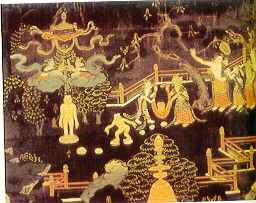 Science:
A major
Buddhist influence on Chinese science was in scientific thought itself. Buddhist
concepts, such as the infinity of space and time, and the plurality of worlds
and of time-cycles or Hindu Kalpas
(chieh) had a stimulating effect on Chinese inquiry, broadening the
Chinese outlook and better equipping it to investigate scientific problems. For
example, the Hindu doctrine of pralayas,
or recurrent world catastrophes in which sea and land were turned upside down
before another world was recreated to go through the four cycles-
differentiation (ch'eng), stagnation (chu), destruction (juai), and emptiness
(kung) - which was later adopted by Neoconfucianists, was responsible for the
Chinese recognition of the true nature of fossils long before they were
understood in Europe. Again, the Indian doctrine of Karma (tso-yeh), or
metempsychosis, influenced Chinese scientific thought on the process of
biological change involving both phylogeny and ontogeny. Buddhist iconography
contained a biological element. Buddhism introduced a highly developed theory of
logic, both formal and dialectical, and of epistemology. Science:
A major
Buddhist influence on Chinese science was in scientific thought itself. Buddhist
concepts, such as the infinity of space and time, and the plurality of worlds
and of time-cycles or Hindu Kalpas
(chieh) had a stimulating effect on Chinese inquiry, broadening the
Chinese outlook and better equipping it to investigate scientific problems. For
example, the Hindu doctrine of pralayas,
or recurrent world catastrophes in which sea and land were turned upside down
before another world was recreated to go through the four cycles-
differentiation (ch'eng), stagnation (chu), destruction (juai), and emptiness
(kung) - which was later adopted by Neoconfucianists, was responsible for the
Chinese recognition of the true nature of fossils long before they were
understood in Europe. Again, the Indian doctrine of Karma (tso-yeh), or
metempsychosis, influenced Chinese scientific thought on the process of
biological change involving both phylogeny and ontogeny. Buddhist iconography
contained a biological element. Buddhism introduced a highly developed theory of
logic, both formal and dialectical, and of epistemology.
Tantric Buddhism reached China in the eighth century
and the greatest Chinese astronomer and mathematician of his time, I-hsing
(682-727), was a Tantric Buddhist monk. While
the work of Indian mathematicians was carried westward by the Arabs and
transmitted to Europe, it was taken eastward by Indian Buddhist monks and
professional mathematicians.
 Astronomy:
There is also some evidence that works on Indian astronomy were in circulation
in China well before the T'ang period. In the annuals of the Sui dynasty,
numerous Chinese translations of Indian mathematical and astronomical works are
mentioned, such as Po-lo-men Suan fa (The Hindu Arithmetical rules) and
Po-lo-men Suan King. These works have vanished, and it is impossible to assess
the degree of their influence on Chinese sciences. However, there is definite
evidence of Indian influence on Chinese astronomy and calendar studies during
the T'ang dynasty. During this period, Indian astronomers were working at the
Imperial Bureau of Astronomy which was charged with preparing accurate
calendars. Yang Ching-fang, a pupil of Amoghavajra (Pu-k'ung), wrote in 764 that
those who wished to know the positions of the five planets and predict what Hsiu
(heavenly mansion) a planet would be traversing, should adopt the Indian
calendrical methods. Five years earlier, Amoghavajra had translated an Indian
astrological work, the Hsiu Yao Ching (Hsiu and Planet Sutra), into
Chinese. Astronomy:
There is also some evidence that works on Indian astronomy were in circulation
in China well before the T'ang period. In the annuals of the Sui dynasty,
numerous Chinese translations of Indian mathematical and astronomical works are
mentioned, such as Po-lo-men Suan fa (The Hindu Arithmetical rules) and
Po-lo-men Suan King. These works have vanished, and it is impossible to assess
the degree of their influence on Chinese sciences. However, there is definite
evidence of Indian influence on Chinese astronomy and calendar studies during
the T'ang dynasty. During this period, Indian astronomers were working at the
Imperial Bureau of Astronomy which was charged with preparing accurate
calendars. Yang Ching-fang, a pupil of Amoghavajra (Pu-k'ung), wrote in 764 that
those who wished to know the positions of the five planets and predict what Hsiu
(heavenly mansion) a planet would be traversing, should adopt the Indian
calendrical methods. Five years earlier, Amoghavajra had translated an Indian
astrological work, the Hsiu Yao Ching (Hsiu and Planet Sutra), into
Chinese.
 At the time there were three astronomical schools at
Chang-an: Gautama (Chhuthan), Kasyapa (Chiayeh), and Kumara (Chumolo). In 684
one of the members of the Gautama school, Lo presented a calendar, Kuang-tse-li,
which has been in use for three years, to the Empress Wu. Later, in 718, another
member of the school, Hsi-ta (Siddhartha), presented to the Emperor a calendar,
Chiu-che-li, which was almost a direct translation of an Indian calendar, Navagraha
Siddhanta of Varahamihira, and which is still
preserved in the T'ang period collection. It was in use for four years. In 729
Siddhartha compiled a treatise based on this calendar which is the greatest
known collection of ancient Chinese astronomical writings. This was the first
time that a zero symbol appeared in a Chinese text, but, even more important,
this work also contained a table of sines, which were typically Indian. I-hsing
(682-727) was associated with the Kumara school and was much influenced by
Indian astronomy. Indian influence can also be seen in the nine planets he
introduced into his calendar, Ta-yen-li. The nine planets included the sun,
moon, five known planets, and two new planets, Rahu
and Ketu, by which the Indian astronomers
represented the ascending and descending nodes of the moon. At the time there were three astronomical schools at
Chang-an: Gautama (Chhuthan), Kasyapa (Chiayeh), and Kumara (Chumolo). In 684
one of the members of the Gautama school, Lo presented a calendar, Kuang-tse-li,
which has been in use for three years, to the Empress Wu. Later, in 718, another
member of the school, Hsi-ta (Siddhartha), presented to the Emperor a calendar,
Chiu-che-li, which was almost a direct translation of an Indian calendar, Navagraha
Siddhanta of Varahamihira, and which is still
preserved in the T'ang period collection. It was in use for four years. In 729
Siddhartha compiled a treatise based on this calendar which is the greatest
known collection of ancient Chinese astronomical writings. This was the first
time that a zero symbol appeared in a Chinese text, but, even more important,
this work also contained a table of sines, which were typically Indian. I-hsing
(682-727) was associated with the Kumara school and was much influenced by
Indian astronomy. Indian influence can also be seen in the nine planets he
introduced into his calendar, Ta-yen-li. The nine planets included the sun,
moon, five known planets, and two new planets, Rahu
and Ketu, by which the Indian astronomers
represented the ascending and descending nodes of the moon.
Chinese
New Year
Dates from 2600 BC - A complete cycle takes 60 years, divided into 12 year
elements. Each of these 12 years is named after an animal
favored by the Buddha.
(source:
China
welcomes the New Year - BBC). Chinese 60 year cycle has
strong resemblance to Tamil Calendar and Indian Hindu Calendars.
For more refer to The
Tamil Calendar).
Medicine
Chinese
medicine, was influenced by Ayurveda, and similarities include the extensive use
of natural herbs.
(source:
Balm from the East - By Jenny Hontz - LA
Times).
According to Terence
Duke " Many Buddhists were familiar with the extensive knowledge
of surgery common to Indian medicine and this aided them both in spreading the
teachings and in their practice of diagnosis and therapy. Surgical technique was
almost unknown within China prior to the arrival of Buddhism.." The
renowned Buddhist teacher Najarjuna is said
to have translated at least two traditional works dealing with healing and
medicines in the first centuries of our era. A section of his
Maha-Prajnaparamita Sutra is quoted by the Chinese monk I Tsing in his
commentary upon the five winds (Chinese: Wu Fung; Japanese: Gofu). This
description enables us to see that the breath Hatha
Yoga termed prana is in fact forming only part of a wider system
known in Buddhism."
(source:
The
Boddhisattva Warriors: The Origin, Inner Philosophy, History and Symbolism of
the Buddhist Martial Art Within India and China p.139-145).
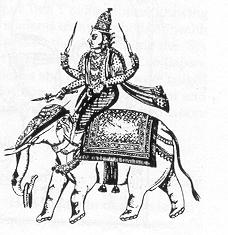 Evidence
of Indian influence on Chinese medicine is even more definite. A number of
Indian medical treatises are found in Chinese Buddhist collections: for example,
the Ravanakumaratantra and Kasyapasamhita. From its very inception, Buddhism
stressed the importance of health and the prevention and cure of mental and
physical ailments. Indian medical texts were
widely known in Central Asia, where parts of the original texts on Ayur Veda
have been found as well as numerous translations. Evidence
of Indian influence on Chinese medicine is even more definite. A number of
Indian medical treatises are found in Chinese Buddhist collections: for example,
the Ravanakumaratantra and Kasyapasamhita. From its very inception, Buddhism
stressed the importance of health and the prevention and cure of mental and
physical ailments. Indian medical texts were
widely known in Central Asia, where parts of the original texts on Ayur Veda
have been found as well as numerous translations.
The T'ang emperors patronized Indian thaumaturges
(Tantric
Yogis) who were believed to possess secret methods of rejuvenation. Wang
Hsuan-chao, who returned to India after the death of King Harsha had been
charged by the Chinese Emperor in 664 to bring back Indian medicines and
physicians.
Considering that Indian medicine, especially
operative surgery, was highly developed for the time, it is not surprising that
the Chinese, like the Arabs, were captivated by Indian medical skills and drugs.
Castration was performed by Chinese methods but other surgical techniques, such
as laparotomy, trepanation, and removal of cataracts, as well as inoculation for
smallpox, were influenced by Indian practices.
Acupuncture
In modern day acupuncture
lore, there is recounted a legend that the discovery of the vital bodily points
began within India as a result of combative research studies undertaken by the
Indian ksatreya warriors in order to discover the vital (and deadly) points of
the body which could be struck during hand-to-hand encounters.
It is said that they experimented upon prisoners by piercing their bodies
with the iron and stone "needles' daggers called Suci daggers. common
to their infantry and foot soldiers, in order to determine these points.
This Chinese legend reflects and
complements the traditional Indian account of its origins, where it is said that
in the aftermath of battles it was noticed that sometimes therapeutic effects
arose from superficial arrow or dagger wounds incurred by the Khastriya in
battle.
(source: The
Boddhisattva Warriors: The Origin, Inner Philosophy, History and Symbolism of
the Buddhist Martial Art Within India and China p.139-145).
The alternative form of medicine known as acupuncture
is believed to have originated in China. In Korean academics, students are
correctly told that acupuncture originated in India. An ancient Sanskrit text on
acupuncture preserved in the Ceylonese National Museum at Columbo in Sri
Lanka.
The
custom of ancestor worship was an adoption of Indian custom. There is
presence of Indian motifs in various Buddhist caves in China.
Martial Arts/Games
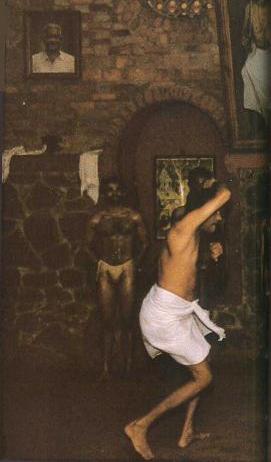 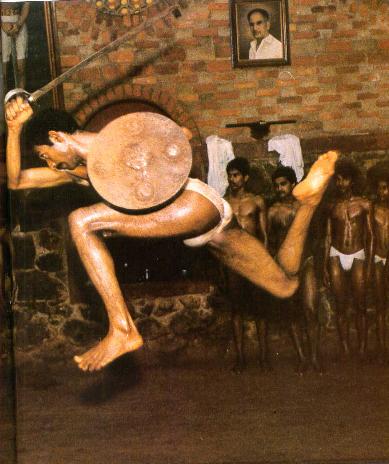
Fighting
without weapons was a specialty of the Ksatreya (caste of Ancient India) and foot
soldier alike.
Danger and Divinity:
Originating at least 1,300 years ago, India's Kalaripayit is the oldest martial
art taught today. It is also one of the most potentially violent. Weaponless but
nimble, a karaipayit master displays for his students how to meet the attack of
an armed opponent.
Watch
Kalari
Martial Arts and
Silambam
Martial Arts video and
How Kung Fu originated from Martial Arts practices of Hinduism
***
According to author
Terence Dukes:
 "Fighting
without weapons was a specialty of the Ksatreya (caste of Ancient India)and foot
soldier alike. For the Ksatreya it was simply part and parcel of their all
around training, but for the lowly peasant it was essential. We read in the
Vedas of men unable to afford armor who bound their heads with turbans called Usnisa
to protect themselves from sword and axe blows. "Fighting
without weapons was a specialty of the Ksatreya (caste of Ancient India)and foot
soldier alike. For the Ksatreya it was simply part and parcel of their all
around training, but for the lowly peasant it was essential. We read in the
Vedas of men unable to afford armor who bound their heads with turbans called Usnisa
to protect themselves from sword and axe blows.
Watch Kalari
Martial Arts and
Silambam
Martial Arts video
Fighting on foot for a Ksatreya was necessary in case he was unseated from his
chariot or horse and found himself without weapons.
Although the high ethical
code of the Ksatreya forbid anyone but another Ksatreya from attacking him,
doubtless such morals were not always observed, and when faced with an
unscrupulous opponent, the Ksatreya needed to be able to defend himself, and
developed, therefore, a very effective form of hand-to-hand combat that combined
techniques of wrestling, throws, and hand strikes.
Tactics and evasion were
formulated that were later passed on to successive generations. This skill was
called Vajramukhti, a name meaning "thunderbolt closed - or clasped -
hands."
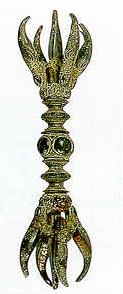 The tile Vajramukti referred to the usage of the hands in a manner
as powerful as the Vajra maces of traditional warfare. Vajramukti was practiced
in peacetime by means of regular physical training sessions and these utilized
sequences of attack and defense technically termed in Sanskrit nata." The tile Vajramukti referred to the usage of the hands in a manner
as powerful as the Vajra maces of traditional warfare. Vajramukti was practiced
in peacetime by means of regular physical training sessions and these utilized
sequences of attack and defense technically termed in Sanskrit nata."
"Prior to and during the life of the Buddha various principles were
embodied within the warrior caste known as the Ksatreya
(Japanese: Setsuri). This title - stemming from Sanskrit root Ksetr meaning
"power," described an elite force of usually royal or noble-born
warriors who were trained from infancy in a wide variety of military and martial
arts, both armed and unarmed.
In China, the Ksatreya were considered to have
descended from the deity Ping Wang (Japanese: Byo O), the "Lord of those
who keep things calm." Ksatreyas were like the Peace force - to keep kings and
people in order. Military commanders were called Senani - a name reminiscent of
the Japanese term Sensei which describes a similar status. The Japanese samurai
also had similar traits to the Ksatreya. Their battle practices and techniques
are often so close to that of the Ksatreya that we must assume the former came
from India perhaps via China. The traditions of sacred Swords, of honorable
self-sacrifice, and service to one's Lord are all found first in
India.
"In
ancient Hinduism, nata was acknowledged as a
spiritual study and conferred as a ruling deity, Nataraja,
representing the awakening of wisdom through physical and mental concentration. However,
after the Muslim invasion of India and its brutal destruction of Buddhist and
Hindu culture and religion, the Ksatreya art of nata was dispersed and many of
its teachers slain. This indigenous martial arts, under the name of Kalari
or Kalaripayit exists only in South India today. Originating at least 1,300 years ago, India's
Kalaripayit is the oldest martial art taught today. It is also the most
potentially violent, because students advance from unarmed combat to the use of
swords, sharpened flexible metal lashes, and peculiar three-bladed daggers.
When Buddhism came to influence India (circa 500
B.c), the Deity Nataraja was converted to
become one of the four protectors of Buddhism, and was renamed Nar (y)ayana Deva
(Chinese: Na Lo Yen Tien). He is said to be a protector of the Eastern
Hemisphere of the mandala."
INDIA

Ksatreya Vajramukti

Simhanta

Bodhisattva Vajramukti

Trisatyabhumi

Trican Nata

Dharmapala

Mahabhuta Pratima

CHINA

Seng Cha

Pu Sa Chin Kang Chuan
(Bodhisattva Vajramukti

(Po Fu) (Huo Ming) (Pa She) (Pai Chin)

Seng Ping

Chuan Fa or Kung Fu

(Karate) (Tae Kwon
Do) (Thai Boxing) (Ju Jitsu) (Judo) (Aikido)
(source: The
Boddhisattva Warriors: The Origin, Inner Philosophy, History and Symbolism of
the Buddhist Martial Art Within India and China p.3
- 158-174 and 242).
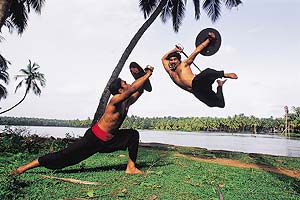 Kalaripayattu,
literally “the way of the battlefield,” still survives in Kerala,
where it is often dedicated to Mahakali. The Kalari grounds are usually situated
near a temple, and the pupils, after having touched the feet of the master,
salute the ancestors and bow down to the Goddess, begin the lesson. Kalari
trainings have been codified for over 3000 years and nothing much has changed. The
warming up is essential and demands great suppleness. Each movement is repeated
several times, facing north, east, south and west, till perfect loosening is
achieved. The young pupils pass on to the handling of weapons, starting with the
“Silambam”, a short stick made of extremely hard wood, which in the olden times could
effectively deal with swords. The blows are hard and the parade must be fast and
precise, to avoid being hit on the fingers! They continue with the swords,
heavy, and dangerous, even though they are not sharpened any more, as they are
used. Without guard or any kind of body protection; they whirl, jump and parry,
in an impressive ballet. Young, fearless girls fight with enormous knives,
bigger than their arms and the clash of irons is echoed in the ground. The
session ends with the big canes, favorite weapons of the Buddhist traveler
monks, which they used during their long journey towards China to scare away
attackers. Kalaripayattu,
literally “the way of the battlefield,” still survives in Kerala,
where it is often dedicated to Mahakali. The Kalari grounds are usually situated
near a temple, and the pupils, after having touched the feet of the master,
salute the ancestors and bow down to the Goddess, begin the lesson. Kalari
trainings have been codified for over 3000 years and nothing much has changed. The
warming up is essential and demands great suppleness. Each movement is repeated
several times, facing north, east, south and west, till perfect loosening is
achieved. The young pupils pass on to the handling of weapons, starting with the
“Silambam”, a short stick made of extremely hard wood, which in the olden times could
effectively deal with swords. The blows are hard and the parade must be fast and
precise, to avoid being hit on the fingers! They continue with the swords,
heavy, and dangerous, even though they are not sharpened any more, as they are
used. Without guard or any kind of body protection; they whirl, jump and parry,
in an impressive ballet. Young, fearless girls fight with enormous knives,
bigger than their arms and the clash of irons is echoed in the ground. The
session ends with the big canes, favorite weapons of the Buddhist traveler
monks, which they used during their long journey towards China to scare away
attackers.
The
“Urimi” is the most extraordinary weapon of Kalari, unique in the world.
This double-edged flexible sword which the old-time masters used to wrap around
the waist to keep coiled in one hand, to suddenly whip at the opponent and
inflict mortal blows, is hardly used today in trainings, for it is
much too dangerous.
This indigenous martial arts, under the name of Kalari
or Kalaripayit exists only in South India today. Kalarippayat
is said to be the world's original martial art. Originating at least 1,300 years ago, India's
Kalaripayit is the oldest martial art taught today. It is also the most
potentially violent, because students advance from unarmed combat to the use of
swords, sharpened flexible metal lashes, and peculiar three-bladed daggers. More
than 2,000 years old, it was developed by warriors of the Cheras kingdom in
Kerala. Training followed strict rituals and guidelines. The entrance to the 14
m-by-7 m arena, or kalari, faced east and had a bare earth floor. Fighters took
Shiva and Shakti, the god and goddess of power, as their deities. From unarmed
kicks and punches, kalarippayat warriors would graduate to sticks, swords,
spears and daggers and study the marmas—the 107 vital spots on the human body
where a blow can kill. Training was conducted in secret, the lethal warriors
unleashed as a surprise weapon against the enemies of Cheras.
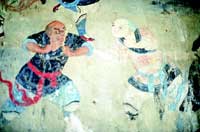 Father
and founder of Zen Buddhism (called C’han in China), Boddidharma,
a Brahmin born in Kacheepuram in Tamil Nadu, in 522 A.D. arrived at the courts
of the Chinese Emperor Liang Nuti, of the 6th dynasty. He taught the Chinese
monks Kalaripayattu, a very ancient Indian martial art, so that they could
defend themselves against the frequent attacks of bandits. In time, the monks
became famous all over China as experts in bare-handed fighting, later known as
the Shaolin boxing art. The Shaolin
temple which has been handed back a few years ago by the communist
Government to the C’han Buddhist monks, inheritors of Boddhidharma’s
spiritual and martial teachings, by the present Chinese Government, is now open
to visitors. On one of the walls, a fresco can be seen, showing Indian
dark-skinned monks, teaching their lighter-skinned Chinese brothers the art of
bare-handed fighting. On this painting are inscribed: “Tenjiku Naranokaku”
which means: “the fighting techniques to train the
body (which come) from India…” Father
and founder of Zen Buddhism (called C’han in China), Boddidharma,
a Brahmin born in Kacheepuram in Tamil Nadu, in 522 A.D. arrived at the courts
of the Chinese Emperor Liang Nuti, of the 6th dynasty. He taught the Chinese
monks Kalaripayattu, a very ancient Indian martial art, so that they could
defend themselves against the frequent attacks of bandits. In time, the monks
became famous all over China as experts in bare-handed fighting, later known as
the Shaolin boxing art. The Shaolin
temple which has been handed back a few years ago by the communist
Government to the C’han Buddhist monks, inheritors of Boddhidharma’s
spiritual and martial teachings, by the present Chinese Government, is now open
to visitors. On one of the walls, a fresco can be seen, showing Indian
dark-skinned monks, teaching their lighter-skinned Chinese brothers the art of
bare-handed fighting. On this painting are inscribed: “Tenjiku Naranokaku”
which means: “the fighting techniques to train the
body (which come) from India…”
Kalari
payatt was banned by the British in 1793.
(Refer
to chapter on European Imperialism).
Watch Kalari
Martial Arts and
Silambam
Martial Arts video
(source:
A
Western Journalist on India: a ferengi's columns - By Francois Gautier
Har-Anand Publications ISBN 8124107955 p. 155-158). Watch
How Kung Fu originated from Martial Arts practices of Hinduism
Yoga has had
an enormous influence on all forms of Indian spirituality, including Hinduism,
Buddhist, and Jain and later on the Sufi and Christian. The teaching of Buddhism
which arose in India are similar to those of yoga: striving toward nirvana and
renouncing the world. Indeed, some kind of meeting between yoga and early
Buddhism certainly took place, and one of the Buddhist schools is actually
called Yogachara (practice of Yoga). Indian Buddhism
spread throughout Asia, some ideas from Yoga were carried into Tibet, Mongolia,
China, and from there on into Japan. Indeed, Zen is a specific form of Yoga's
dhyana or 'transcendental meditation' and the word Zen (like the Chinese tchan)
is a simple phonetic development from Sanskrit dhyana.
(For information on Yoga, refer to chapter on Yoga
and Hindu Philosophy). For
more refer to Kalarippayattu
and Kalari
Payatte - The martial art of kerala
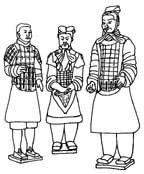 The famous Shao-lin style of boxing is also
attributed to Indian influence. Bodhidharma,
(8th century AD) who believed in a sound mind in a
sound body, taught the monks in the Shao-lin temple this style of boxing for
self-defense for rejuvenating the body after exacting meditation and mental
concentration. The famous Shao-lin style of boxing is also
attributed to Indian influence. Bodhidharma,
(8th century AD) who believed in a sound mind in a
sound body, taught the monks in the Shao-lin temple this style of boxing for
self-defense for rejuvenating the body after exacting meditation and mental
concentration.
According to the History channel martial arts were introduced in China by an
Indian named Bodhidharma, who taught it to
the monks so that they could defend their monasteries. He was also said to have
introduced the concept of vital energy or chi ("prana"
probably corresponds to this). This concept
is the basis acupuncture.
Chuan Fa, the Buddhist martial
arts, preserved many Ksatreya techniques in their original forms. The
monks to practiced Chuan Fa were often the sole preservers of the Ksatreya art
of Avasavidya,
called in Chinese Huo Ming or Hua Fa.
During the first millennium, Indian racing games
reached China. The well-known expert on the history of Chinese games, Karl
Himly,
on the authority of a passage from the Jun Tsun Su, a work of the Sung period
(960-1279), suggests that the Chinese game t'shu-p'u was invented in western
India and spread to China in the time of the Wei dynasty (220-265). T'shu'p'u
is, in fact, the Chinese adaptation of the Indian chatus-pada (modern
chupur).
Chess was introduced from India, ca. 700. through the ancient trade route from
Kashmir. The oldest and best of the native Chinese games, wei-ch'i, did not
appear until 1000. Cubical dice (chu-p or yu-p'i), although found in ancient
India and Egypt, are generally believed to have reached China from India,
possibly quite early. Arthur Waley is of the opinion that the prominence of the
number six in the Book of Changes was derived from the six sides of cubical
dice. In
China the first indisputable sources appeared only around 800 AD. "The
King of Kanauj had sent the game of chess to the court of Sasanian King Kusrau I
Anshirvan (531-579).
Education
 The University of Nalanda built in the 4th century BCE was one of the greatest
achievements of ancient India in the field of education. The Chinese scholar and traveler
Hiuen Tsang
(600-654
AD) stayed at the Nalanda University in the
7th century, and has left an elaborate description of the excellence, and purity of
monastic life practiced here.
He
found Indians “high-minded,
upright and honorable.
The University of Nalanda built in the 4th century BCE was one of the greatest
achievements of ancient India in the field of education. The Chinese scholar and traveler
Hiuen Tsang
(600-654
AD) stayed at the Nalanda University in the
7th century, and has left an elaborate description of the excellence, and purity of
monastic life practiced here.
He
found Indians “high-minded,
upright and honorable.
China
received Mahayanic Buddhism and Sanskrit texts from the Central-Asian provinces
of India in 67 A.D. After that China became Hinduized not only in theology and
metaphysics, but in every department of thought and activity. Thousands of
Hindus lived in Chinese cities, eg. at Changan in the N.W. and at Canton on the
sea, as priests, teachers, merchants, physicians, sculptors and
"interpreters." The name of Chinese tourists, students, philosophers,
and translators, also, in India is legion. The Chinese founded their drama on
Hindu precedents, imported musical instruments (stringed) from India, and
introduced even some of the acrobatic feats, dances and sports prevalent among
the Hindus.
During
his Indian tour the great Itsing (634-712) mastered Hindu medicine at the
University of Nalanda. Hindu mathematics and logic were cultivated among the
intellectuals of China; Sanskrit treatises on painting and art criticism, eg.
Sadamga (six limbs of painting) in Vatsayana's Kamasutra (erotics),
Chitralaksana (marks of painting), etc. furnished the canons of the Chinese art
during its greatest epoch (Tang and Sung Dynasties 600-1250); and the
traditional Confucianism had to be reinterpreted, eg. by Chu-Hsi (1130-1200) in
the light of the imported Hindu philosophy. China
became a part of "Greater India" in poetry, aesthetics,
folk-festivals, morals, manners, and sentiments. The
"Augustan Age" of Chinese culture, the age of the mighty Tangs and
brillant Sungs, was the direct outcome of the "holy alliance" for
centuries between India and China.
(source:
Creative India - By Benoy Kumar Sarkar p.
78-79). For more on education, refer to chapter on Education
in Ancient India).
***
Ling
Yin Temple and India
Lin
Yin Temple is home to the 19-metre-high Golden
Buddha statue. Inscriptions found in the temple say the statue came flying
from India.
Fei Lai Feng - Peak Flown From Afar
(also named Ling Jiu Feng), stands next to Lin Yin Temple and is a
must-see in Hangzhou, Zhejiang Province. There are many legends about the peak's
name. A well-known legend states that an Indian monk
named Huili arrived in the valley 1,600 years ago and was surprised to see a
peak so dissimilar from any other one in the valley. He believed that the peak
had flown over from India because the shape, although unique in China, was
common in India. However, he did not know why the peak would have
flown to this spot so far from his country.
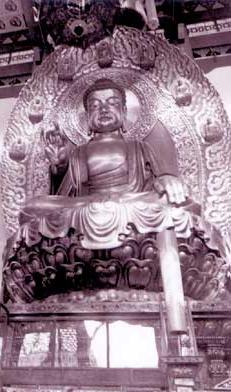
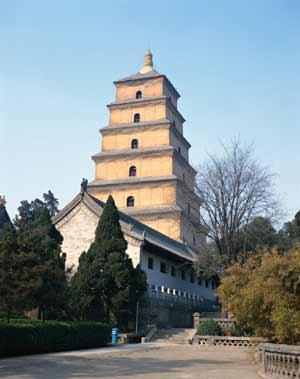
Inscriptions
found in the temple say the statue came flying from India. Big
Wild Goose Pagoda - Dayanta - Sanskrit scriptures he had brought back from India.
For
more refer to chapter on Greater
India: Suvarnabhumi and Sacred
Angkor.
***
Big
Wild Goose Pagoda (Da Yan Ta - Dayanta) which was built in 652 AD
in the Tang Dynasty. Xuanzang, a prominent Buddhist scholar of the time, planned
to have a huge stone pagoda built to house the Sanskrit
Buddhist scriptures he had brought back from India. It contains
a large volume of Buddhist scriptures which were obtained from India by the
eminent monk Xuanzang. The pagoda was modeled after the one
in India. It was given the same name in memory of Xuan Zang in praise
of Buddhism.
(source:
Ling
Yin Temple and travelchinaguide.com
and visitchina).
***
Hindu temples of Quanzhou – A Forgotten History of China 
Shiva temple in China
Kublai Khan, the founder of Yuvan dynasty of China constructed a Shiva temple in
China .There is an inscription referring to this in the temple. The most
interesting part is this inscription is bilingual and has both Tamil and Chinese
scripts . The last line of the inscription is in Chinese. Quanzhou is a port
city in China. This city had lot of trade relations with ancient Tamil kings .
It is believed the Siva temple at Quanzhou was raised for the well being of
Mangolian king Kublai Khan . Kublai Khan was also known as Sekasai Khan. Kublai
Khan was the grandson of Chenkiz Khan. It is reported Kublai Khan built Beijing
city
moved the capital to Beijing. The Quanzhou Siva temple was known as
Thirukathaleswaram in Tamil and Lord Shiva was known as Thirkathaleswaran. This
is mentioned in the Tamil-Chinese epigraph stone.This temple was built by Kublai
Khan in 1260 AD. This inscription is still available in the temple. It is
believed there were more than a dozen Hindu temples in China .It is also
believed a community of Tamil Traders lived in this Chinese port city during
during the Song (960-1279) and Yuan (1279-1368) dynasties. In the Chedian
village of Quanzhou there is a “cross-legged” “four-armed goddess” with a ”demon
lying at her feet.” She is not a Chinese Goddess, ' “Even though most of the
villagers still think she is Guanyin”.
***
Hindu Temple in China: Shiva temple was originally built in 685 AD during the
Tang dynasty and was rebuilt in the 13th century by Tamils. Quanzhou
and its surrounding area consists of shrines or temples that according to
historians is part network of number of Hindu shrines and temple.The
history of Quanzhou’s temples and its Tamil links were forgotten history until
1930s when archaeologist Wu Wenliang from Quanzhou unearthed the carved stones
showing perfectly rendered images of the
god Narasimha
(the incarnation of lord Vishnu half man half lion form), Elephant statues, and
images of lord Shiva were also found bearing the pattern and style that was
identical to temples Andhra Pradesh and Tamil Naidu from same time span.
The stones come from period of Yuan Dynasty in 13th century when close trade
links were developed with south India. She further said that they believe that
work was done by the Chinese workers but the designs were brought by the
traders. The earliest record of indian residing in Quanzhou dates back to the
6th century. An inscription from the Song Dynasty time period was found on Yanfu
temple.
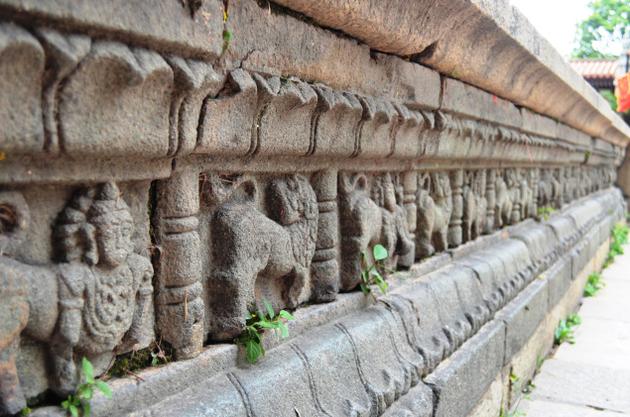
Carvings on temple walls.
***
In and around Quanzhou, a bustling industrial city,
there are shrines that historians believe may have been part of a network of
more than a dozen Hindu temples and shrines. For the residents of Chedian, a few
thousand-year-old village of muddy by-lanes and old stone courtyard houses, she
is just another form of Guanyin, the female Bodhisattva who is venerated in many
parts of China. But the goddess that the residents of this village pray to every
morning, as they light incense sticks and chant prayers, is quite unlike any
deity one might find elsewhere in China. Sitting cross-legged, the four-armed
goddess smiles benignly, flanked by two attendants, with an apparently
vanquished demon lying at her feet.
Local scholars are still unsure about her identity,
but what they do know is that this shrine’s unique roots lie not in China, but
in far away south India. The deity, they say, was either brought to Quanzhou — a
thriving port city that was at the centre of the region’s maritime commerce a
few centuries ago — by Tamil traders who worked here some 800 years ago, or
perhaps more likely, crafted by local sculptors at their behest.
“This is possibly the only temple in China where we
are still praying to a Hindu God,” says Li San Long, a Chedian resident, with a
smile. “Even though most of the villagers still think she is Guanyin!” Mr. Li
said the village temple collapsed some 500 years ago, but villagers dug through
the rubble, saved the deity and rebuilt the temple, believing that the goddess
brought them good fortune — a belief that some, at least, still adhere to.
The Chedian shrine is just one of what historians
believe may have been a network of more than a dozen Hindu temples or shrines,
including two grand big temples, built in Quanzhou and surrounding villages by a
community of Tamil traders who lived here during the Song (960-1279) and Yuan
(1279-1368) dynasties.
The history of Quanzhou’s temples and Tamil links was largely
forgotten until the 1930s, when dozens of stones showing perfectly rendered
images of the god Narasimha — the man-lion avatar of Vishnu — were unearthed by
a Quanzhou archaeologist called Wu Wenliang. Elephant statues and images
narrating mythological stories related to Vishnu and Shiva were also found,
bearing a style and pattern that was almost identical to what was evident in the
temples of Tamil Nadu and Andhra Pradesh from a similar period.
The Maritime Museum has now opened a special exhibit showcasing
Quanzhou’s south Indian links. Ms. Wang says there is a renewed interest — and
financial backing — from the local government to do more to showcase what she
describes as the city’s “1000-year-old history with south India,” which has been
largely forgotten, not only in China but also in India.
(source:
Behind China’s Hindu Temples, a Forgotten History - indiadivine.org).
***
Mahabharata
in Chinese sold out, goes into second edition

There
is a growing desire in China to learn about India's culture and traditions.
"For a long time, Chinese scholars paid too much attention to the West.
Now, there is a growing desire to know Indian civilisation and imbibe its
wisdom," Huang Baosheng, who headed the
five-member team of translators at Beijing University.
"The 5,000 sets released in the first edition were bought not just by
libraries as happens m the case of most such works - but also by ordinary
readers," Huang, who is a teacher at the university's Sanskrit
department,
said. The sets are moderately priced at 680 yuan (Rs 3,862) each.

Sanskrit
Poet - Kalidasa
Shanghai
unveils statue of Sanskrit poet Kalidasa in 2006
on one of its most important streets, something that few Indian cities can
boast about.
A bronze bust of the poet was unveiled at the Shanghai Theatre Academy on a
street called 'Shanghai theatre way', which is being developed as the cultural
and artistic hub of the eastern metropolis.
Shanghai is one of the few world cities outside India, if any, to sport a statue
of the great 5th century poet.
(source:
Bharatkalyan97. A Homage to Hindu Civilization).
***
Huang and his team worked for over 10 years translating the epic from the
Sanskrit edition brought out by the Bhandarkar Oriental
Research Institute in Pune. The institute's
version, Huang said, is the best of the epic in Sanskrit.
"The Chinese version has more than 30 illustrations taken from the
original. The work has been appreciated by scholars around the world, including
those from Harvard, who recently visited us in Beijing." The Mahabharata's
version comes several years after the Ramayana was translated into Chinese. Ji
Xianlin, a Sanskrit scholar, secretly translated the epic in 1976. Huang and
most Sanskrit scholars in China are students of the 95-year-old Ji, who is now
in hospital near the university. The other scholars involved in the Mahabharata
project are Huang's wife Guo Liang Yun, and Ge Weijun, Li Nan and Duan Qin.
(source: Mahabharata
in Chinese sold out, goes into second edition - By Saibal Dasgupta - timesofindia.com
November 22, 2006).
Refer
to chapter on Hindu
Scriptures.
Top of Page
Bhaarat's
influence on Japan
Hinduism and Buddhism went from India to
China and Korea to Japan. Images of Ganesha and Vishnu have been found
throughout Japan. Numerous Buddhist deities were introduced into Japan and many
of these are still very popular.
According to D. P.
Singhal, "some
Hindu gods, who had been incorporated into the Buddhist pantheon, were amongst
them. For example, Indra,
originally, the god of thunder but now also the king of gods, is popular in
Japan as Taishaku
(literally the great King Sakra); Ganesha
is worshipped as Sho-ten
or Shoden (literally, holy god)
in many Buddhist temples, and is believed to confer happiness upon his devotees.
A sea-serpent worshipped by sailors is called Ryujin, a Chinese equivalent of
the Indian naga. Hariti and Dakini
are also worshipped, the former as Kishimo-jin, and the latter by her original
name. Bishamon is a Japanese equivalent of the Indian Vaisravana (Kubera),
the god of wealth.
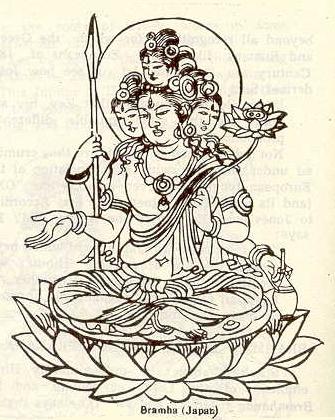
Brahma - Japan.
***
Even Shinto adopted Indian gods, despite
its desperate efforts after the Meiji Revolution to disengage itself from
Buddhism. The Indian sea god Varuna,
is worshipped in Tokyo as Sui-ten (water-god); the Indian goddess of learning, Saraswati,
has become Benten (literally, goddess of speech), with many shrines dedicated to
her along sea coasts and beside lakes and ponds. Shiva
is well known to the Japanese as Daikoku (literally, god of darkness), which is
a Chinese and Japanese equivalent of the Indian Mahakala, another name of Shiva.
Daikoku is a popular god in Japan. At the Kotohira shrine on the island of
Shikoku, sailors worship a god called Kompera, which is a corruption of the
Sanskrit word for crocodile, Kumbhira. The divine architect mentioned in the Rig
Veda, Vishvakarma,
who designed and constructed the world, was regarded in ancient Japan as the god
of carpenters, Bishukatsuma. The Indian Yama, the god of death, is the most
dreaded god of Japan, under the name of Emma-o, the king of hell.
According to author Donald
A. Mackenzie: "The Indian form of myth of the Churning
of the Milky Ocean reached Japan. In a Japanese illustration of it
the mountain rests on a tortoise, and the supreme god sits on the summit,
grasping in one of his hands a water vase. The Japanese Shinto myth of creation,
as related in the Ko-ji-ki and Nihon-gi,
is likewise a churning myth. Twin deities, Izanagi, the god, and Izanami, the
goddess, sand on "the floating bridge of heaven" and thrust into the
ocean beneath the "Jewel Spear of Heaven". With this pestle they churn
the primeval waters until they curdle and form land."
(source: Myths
of Pre-Columbian America - By
Donald A. Mackenzie ASIN 185958490X p.190-191).
The climbers wearing traditional white
dress, who scale the sacred Mount Ontake as a religious observance, sometimes
have inscribed on their robe Sanskrit Siddham characters of an ancient type.
Sometimes they put on white Japanese scarfs (tenugui) which carry the Sanskrit
character OM, the sacred syllable of the Hindus.
According to Terence
Dukes, "The Gagaku dances of Japan contain many movements
derived from the Indian Nata and the Chinese
Chuan Fa."
(source: The
Boddhisattva Warriors: The Origin, Inner Philosophy, History and Symbolism of
the Buddhist Martial Art Within India and China p.206).
The cultivation of cotton in Japan is
traced to an Indian who had drifted to the shore of Aichi Prefecture in 799. To
commemorate the event, the Japanese named the village where the shipwrecked
Indian had landed Tenjiku; Tenjiku was the Japanese name for India, and means
Heaven.
 The popular Japanese game of sunoroku or
sugoroku (backgammon played at the royal of the Nara rulers and still popular in
Japan is of Indian origin. In Japan the game is played as nard. Nard is
generally regarded as an Iranian game, but the ninth century Arab scholar, Al
Yaqubi, considered nard an Indian invention
used to illustrate man's dependence on chance and destiny. According to Wei-Shu,
sugoroku was brought to China in ancient times from Hu country, which at that
time meant a country somewhere in the vicinity of India. Again, as Karl Himly
has pointed out, the Hun Tsun, Sii, written during the Sung period (960-1279),
states that t'shu-pu, another Chinese name for sugoruku, was invented in western
India, that it was known in its original form as chatushpada,
and that it reached China during the Wei period (220-265). The popular Japanese game of sunoroku or
sugoroku (backgammon played at the royal of the Nara rulers and still popular in
Japan is of Indian origin. In Japan the game is played as nard. Nard is
generally regarded as an Iranian game, but the ninth century Arab scholar, Al
Yaqubi, considered nard an Indian invention
used to illustrate man's dependence on chance and destiny. According to Wei-Shu,
sugoroku was brought to China in ancient times from Hu country, which at that
time meant a country somewhere in the vicinity of India. Again, as Karl Himly
has pointed out, the Hun Tsun, Sii, written during the Sung period (960-1279),
states that t'shu-pu, another Chinese name for sugoruku, was invented in western
India, that it was known in its original form as chatushpada,
and that it reached China during the Wei period (220-265).
There is some Indian influence on
Japanese art. A similarity between Shinto
rituals and Hindu rituals (for example ringing the bell as one
enters the temple). Narushima (Narasimha) Bishamondo is a famous temple in
Japan.
(source:
India
and World Civilization - By D. P. Singhal). For more on Japan refer to
chapter on Suvarnabhumi).
The influence of Indian thought and
culture on Japan was very great. Maurice Winternitz,
while reviewing Geschichte der Japanischen Literature,
says:
"In view of
so much Indian influence in Japanese literature, it is possible to assume that
the 'Keuyogen' or double meaning of Japanese poetry may in any way be connected
with that form of Alankara of the Indian Kavya, which is exactly in the same
method."
The distinguished Japanese scholar, Mr.
J. Taka Kusu, says: " But I should like to emphasize the fact
that the influence of India, material and intellectual, must have been much
greater in an earlier period than we at present consider to have been the case.
There were, for instance, several Indians, whom the Kuroshiwo current, washing
almost the whole southern coast, brought to the Japanese shore." He further
says, " It cannot be denied that several Indians came to Japan, especially
in view of so many Indians finding their way to China by sea."
He then relates how a Brahmin
Bodhisen Bharadvaja, known generally as the "Brahmin Bishop" came with
another priest from India via Champa (Cochin China) to Osaka, then to Nara,
where they met another Indian ascetic and taught Sanskrit to the Japanese.
"His monastery and tombstone, with a written eulogy, still exist in Nara.
Just at the time a Japanese alphabet or syllables is said to have been invented.
The fifty syllables, Gojuin, are arranged by a hand, evidently with a practical
knowledge of Sanskrit method."
(source: Journal
of Royal Asiatic Society for 1905, p. 872-873). The official record of Japan, Nihon-ki
and Ruijukokushi describe how cotton was introduced in Japan by two Indians who
reached Japan in July 799 and April 800 A.D.
(For more refer to Vide Dr. Taka
Kusu's "What Japan owes to India" in the Journal of the
Indo-Japanese Association for January, 1910). It is noteworthy that some of the
scriptures of the Japanese priests preserved in the Horyuji Temple of Japan are
written in Bengali characters of the eleventh century.
(source: Daito Shimaji's "
India an Japan in Ancient Times," in the Journal of Indo-Japanese
Association for January 1910).
Top of Page
Common Terms:
Sanskrit/Chinese/Japanese
| Archarya - Master |
Achali |
Ajari |
| Dharma - Law |
FA |
Ho |
| Pratima - movement warrior
techniques of the Hindu ksatreyas |
Hsing |
Kata |
| Sunyatapani - |
Tang-Shou |
Karate/To De |
| Dharmahasta |
Chuan Fe |
Kempo |
| Marga - The Way |
Tao |
Do |
| Guhya-Sutra |
Mi-Ching |
Mikkyo |
| Nagarjuna |
Lung Shu |
Ryuju/Ryusho/Ryumyo |
| Mudra - ritual gesture |
Yin |
In |
| Mandala a special zone or area |
Mantolo |
Mandara |
| Vajramukti |
Ching Kang, Chieh T'o |
Kongogedastsu |
| Sangha - congregation or group
followers |
Seng |
So |
| Narya - strong or manly |
Na-Li |
Nara, Naha |
| Nata |
Na-Pa, Na-Ra |
Nara, Napa, Nafa |
| Yoga - to yoke |
Yui Cha |
Yu Ga |
(source: The
Boddhisattva Warriors: The Origin, Inner Philosophy, History and Symbolism of
the Buddhist Martial Art Within India and China p.485-491).
(For
more refer to chapter on Greater
India: Suvarnabhumi and Sacred
Angkor).
Conclusion
In conclusion, it can be said that China was more
influenced by India than India by China. Whilst Chinese monks came to acquire
knowledge and take it back, the Indian monks went to China on specific religious
missions to impart knowledge. There is hardly any evidence that the Chinese
monks brought with them any work which was translated into an Indian language. It
seems that during this period of Sino-Indian contact, the psychological
atmosphere was one in which India was naturally accepted as the giver and China
as the taker. Whilst the best in Indian thought
was carefully studied and carried back to China, Chinese ideas filtered through
India whether they represented the best of their culture or not.
According to Jawaharlal
Nehru in his book "The
Discovery of India"
"The most famous of the Chinese travelers to
India was Hsuang Tsang who
came in the seventh century when the great T'sang dynasty flourished in China
and King Harshavardhana ruled over in North India. Hsuang-Tsang took a degree of
Master of the Law at Nalanda University
and finally became vice-principal of the university.
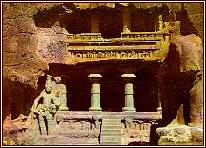 His book the Si-Yu-Ki or
the Record of the Western Kingdom (meaning India), makes fascinating reading. He
tells us of the system of the university where the five branches of knowledge
were taught. 1. Grammar 2. Science of Arts and Crafts 3. Medicine 4. Logic
and 5. Philosophy. Hsuan-Tsang was particularly
struck by the love of learning of the Indian people. Many
Indian classics have been preserved in Chinese translation relating not only to
Buddhism but also to Hinduism, astronomy, mathematics, medicine, etc. There are
supposed to be 8,00 such works in the Sung-pao collection in China. Tibet is
also full of them. There used to be frequent co-operation between Indian,
Chinese and Tibetan scholars. A notable instance of this co-operation, still
extant, is a Sanskrit-Tibetan-Chinese dictionary of Buddhist technical terms.
This dates from the ninth century and is named the 'Mahavyutpatti.' His book the Si-Yu-Ki or
the Record of the Western Kingdom (meaning India), makes fascinating reading. He
tells us of the system of the university where the five branches of knowledge
were taught. 1. Grammar 2. Science of Arts and Crafts 3. Medicine 4. Logic
and 5. Philosophy. Hsuan-Tsang was particularly
struck by the love of learning of the Indian people. Many
Indian classics have been preserved in Chinese translation relating not only to
Buddhism but also to Hinduism, astronomy, mathematics, medicine, etc. There are
supposed to be 8,00 such works in the Sung-pao collection in China. Tibet is
also full of them. There used to be frequent co-operation between Indian,
Chinese and Tibetan scholars. A notable instance of this co-operation, still
extant, is a Sanskrit-Tibetan-Chinese dictionary of Buddhist technical terms.
This dates from the ninth century and is named the 'Mahavyutpatti.'
Soon after Hsuan-Tsang's death in China, yet another
famous pilgrim made the journey to India - I-tsing
(or Yi-tsing). He also studied at Nalanda University for a long time and carried
back several hundred Sanskrit texts. He refers to India as the West (Si-fang),
but he tells us that it was known as Aryadesha
- Arya means noble, and desha region - the noble region. It is so called
because men of noble character appear there successively, and people all praise
the land by that name. It is also called the Madhyadesha
- the middle land, for it is in the center of a hundred myriads of
countries.
(source: The
Discovery of India - By Jawaharlal Nehru p.
193-194).
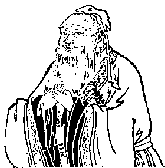 Yet Chinese
culture had some influence on India. The gabled roofs of houses on the western
coast of India show a Chinese influence, as do the temples and houses in the
Himalayan regions. Some Chinese influence is noted on Gupta coins. The use of a
certain kind of silk (china-msuka) in India, different kinds of fruits including
pears (cinaraja-putra), peaches (cinani), and lichis, the technique of fishing
in the backwaters, and the porcelain industry all owe something to Chinese
influence. Indians also learned the art of papermaking from China. Yet Chinese
culture had some influence on India. The gabled roofs of houses on the western
coast of India show a Chinese influence, as do the temples and houses in the
Himalayan regions. Some Chinese influence is noted on Gupta coins. The use of a
certain kind of silk (china-msuka) in India, different kinds of fruits including
pears (cinaraja-putra), peaches (cinani), and lichis, the technique of fishing
in the backwaters, and the porcelain industry all owe something to Chinese
influence. Indians also learned the art of papermaking from China.
(For
more refer to chapter on Greater
India: Suvarnabhumi and Sacred
Angkor). Refer to
Marco Polo’s epic journey to China was a big con –
Team Folks
Top of Page
Articles
India and China
By V. B. Metta
http://www.geocities.com/Athens/Academy/5185/2-2china.html
It is a curious fact that Chinese culture, though so distinctive,
all-pervasive and compulsive, could not come to India, or if it did come, it could not
leave any lasting marks behind it.
 Archaeologists and scholars tell us that Chinese ideas
and ideals came to India with the Kushan Kings of the North, who were Tartars, but the
influence that that dynasty has left on India is almost negligible. We are also told that
there is influence of Chinese art on the Ajanta paintings. But that is only a theory,
since there is nothing characteristically Chinese about these frescoes. The influence of
India on China however is undeniable. It is not merely in religion that India influenced
China, but in most subjects that go to make up national culture. Archaeologists and scholars tell us that Chinese ideas
and ideals came to India with the Kushan Kings of the North, who were Tartars, but the
influence that that dynasty has left on India is almost negligible. We are also told that
there is influence of Chinese art on the Ajanta paintings. But that is only a theory,
since there is nothing characteristically Chinese about these frescoes. The influence of
India on China however is undeniable. It is not merely in religion that India influenced
China, but in most subjects that go to make up national culture.
The Chinese, always proud of their civilization, looked upon the
outside world with contempt. They called the tribes living to their North "Hun
slaves," and the tribes living to the North-West "barbarians," while the
Japanese were denominated by them "Dwarf Pirates." But their attitude towards
India was different. India was known to them by a number of names, not one of which was
contemptuous. She was called Hsin Tu, the Kingdom of the Hindus, or Ti Yu, the Western
Land; to Buddhists she was Fu Kuo, the Land of the Buddhas.
Pre-Buddhistic Influence
 It is probable that there was contact between India and China even before
the birth of Buddha; certain similarities of thought and belief between pre-Buddhist
Indians and pre-Confucian Chinese go to strengthen that theory. According to Hindus, the
world sprang from the union of Purusha and Prakriti, the Male and Female
Principles; the ancient Chinese writers thought the same—the Purusha and Prakriti of
Indians being called Yang and Yin in China. There is also the worship of mountains in both
countries; what the Himalayas have been to Hindus that Mount Tai has been to the
Celestials. I do not think that these are mere coincidences due to the similarity of all
early beliefs. There was a good deal of action and reaction of early Asiatic civilizations
upon each other of which a proper history has yet to be written. It is probable that there was contact between India and China even before
the birth of Buddha; certain similarities of thought and belief between pre-Buddhist
Indians and pre-Confucian Chinese go to strengthen that theory. According to Hindus, the
world sprang from the union of Purusha and Prakriti, the Male and Female
Principles; the ancient Chinese writers thought the same—the Purusha and Prakriti of
Indians being called Yang and Yin in China. There is also the worship of mountains in both
countries; what the Himalayas have been to Hindus that Mount Tai has been to the
Celestials. I do not think that these are mere coincidences due to the similarity of all
early beliefs. There was a good deal of action and reaction of early Asiatic civilizations
upon each other of which a proper history has yet to be written.
With the rise of Buddhism we are, historically
speaking, on firmer ground. It is said that Asoka’s missionaries had gone to China.
There are however no records left of it. But we do know as a matter of historical fact
that in 67 A.D., the Emperor Ming Ti received Kashyapamadanya from India, who bore with
him presents of images and sculptures for the Chinese emperor. Since then the intercourse
between the two countries continued uninterrupted till at least the eighth century. During
that time it is estimated that between thirty to forty Indian scholars went to China, and
some two hundred Chinese scholars came to India, who took back with them to their country
Indian books, paintings, and statues.
The influence of India on China can be traced on
Music,
Architecture, Painting, Sculpture, Literature, Mythology, Philosophy and Science.
Influence of Hindu Music
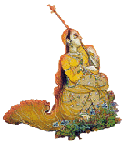 We learn from Chinese writers that Indian music had displaced
Chinese music in the seventh century in northern China; records of this music are said to
be preserved in Japan. Although Chinese architecture is mainly wooden, still Indian
architecture has succeeded in influencing it. There were certain temples built during the
Tang Period in China which were the offspring of Indian and Chinese styles of
architecture. Those temples are however in ruins now, and so they cannot be studied
properly. But the Chinese pagoda fortunately still exists. It is called Chinese, though
the country of its origin was Nepal. The Newars, a people living in the Valley of Nepal,
evolved it by making certain alterations in the Hindu temple. Those alterations were: (1)
They built the pagoda on a platform and not on the ground direct like the Hindu temple;
(2) They tilted up the roof of their building, mainly because the rainfall in the country
is very heavy. Mr. Ernest Havell is of opinion that the pagoda was a modification of the
stupa,
while Mr. Sylvain Levi thinks that it represents an Indian style of architecture which has
now disappeared. When the pagoda went from Nepal to Tibet and from thence to China is not
definitely known yet. The oldest pagoda in China is, I think, of the sixth century. We learn from Chinese writers that Indian music had displaced
Chinese music in the seventh century in northern China; records of this music are said to
be preserved in Japan. Although Chinese architecture is mainly wooden, still Indian
architecture has succeeded in influencing it. There were certain temples built during the
Tang Period in China which were the offspring of Indian and Chinese styles of
architecture. Those temples are however in ruins now, and so they cannot be studied
properly. But the Chinese pagoda fortunately still exists. It is called Chinese, though
the country of its origin was Nepal. The Newars, a people living in the Valley of Nepal,
evolved it by making certain alterations in the Hindu temple. Those alterations were: (1)
They built the pagoda on a platform and not on the ground direct like the Hindu temple;
(2) They tilted up the roof of their building, mainly because the rainfall in the country
is very heavy. Mr. Ernest Havell is of opinion that the pagoda was a modification of the
stupa,
while Mr. Sylvain Levi thinks that it represents an Indian style of architecture which has
now disappeared. When the pagoda went from Nepal to Tibet and from thence to China is not
definitely known yet. The oldest pagoda in China is, I think, of the sixth century.
In painting, India influenced
China considerably. From the East Chin dynasty to the Tang dynasty there was continuous
intercourse between the two countries, and Indian paintings went to China in great numbers
and influenced, if not actually displaced for a time Chinese painting in the North. This
Indian School of Painting flourished in China till the rise to power of the Southern Sungs
who favored the purely Chinese style of painting. I shall never forget the exquisite,
ethereally delicate pictures painted on silk of this period which I saw at an exhibition
at Messrs. Yamanaka’s art galleries in New York in 1923. The manager of the galleries
on seeing that I was an Indian, approached me, and pointing at the pictures in front of
us, remarked with his inimitable Japanese smile, "They are all Indian really!"
Then there are the wall paintings of the Tun Huang Caves (the Caves of the Thousand
Buddhas) which Sir Aurel Stein and others have recently excavated in Chinese
Turkestan.
 A Chinese writer tells us that before the
introduction of Buddhism there was no sculpture in three dimensions in China. But most of
the early Chinese Buddhist sculpture was destroyed by an Emperor who was anti-Buddhist.
There are, however, the rock sculptures and reliefs at Lo Yang and Lung Men of that period
still left intact which show the influence of Indian sculpture on them. There are also
sculptures to be found at Yung Kwang which closely resemble the Indo-Greek sculptures of
Gandhara. A Chinese writer tells us that before the
introduction of Buddhism there was no sculpture in three dimensions in China. But most of
the early Chinese Buddhist sculpture was destroyed by an Emperor who was anti-Buddhist.
There are, however, the rock sculptures and reliefs at Lo Yang and Lung Men of that period
still left intact which show the influence of Indian sculpture on them. There are also
sculptures to be found at Yung Kwang which closely resemble the Indo-Greek sculptures of
Gandhara.
The Sanskrit language and literature have influenced China to a certain extent,
since the Buddhist Scriptures had to be translated into Chinese. On account of the study
of Sanskrit—which, by the way, is the language of the Mahayana Buddhism and not Pali
as some people imagine—the Chinese were inspired to invent an alphabetical system.
This alphabetical system which has now disappeared, was called Ba-lamen Shu or Brahminical
writing. Sakuntala, the masterpiece of the great Indian dramatist
Kalidasa, was translated into Chinese, and is said to have influenced the Chinese drama. In
mythology, many Buddhist deities of India were adopted by the Chinese; for example, Kwan
Yin, the Chinese Goddess of Mercy, was the Indian Tara.
It has been suggested that
Lao Tze got his idea of Tao—the Way—from the Hindu Brahman, Universal Soul.
It is likely that the Indian sciences of Astronomy and Medicine influenced the
astronomical and medical sciences of the Chinese. There is very good scope for a competent
scholar to make a full study of Indian influence on China and other Far-Eastern countries,
and write a book on the subject.
Top of Page
British Imperialism and
Christian Missionaries in China
(excerpts from Glimpses
of World History - By Jawaharlal Nehru
(1934) p. 445-449)
India had sent in the past many a
good thing to China. Bt
the Opium war with Britain was a beginning of a unsavory
chapter in Chinese history.
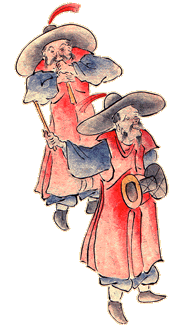 This
was the beginning of China's troubles with the imperialistic Powers of the West.
Her isolation was at an end. She had to accept foreign trade; and she had to
accept, in addition, Christian missionaries. These
missionaries played an important part in China as the vanguard of imperialism.
Many of China's subsequent troubles had something to do with missionaries. Their
behavior was often insolent and exasperating, but they could not be tried by
Chinese courts. Under the new treaty foreigners from the West were not subject
to Chinese law or Chinese justice. They were tried by their own courts. This was
called "extra-territoriality", and it still exists, and is much
resented. The converts of the also claimed this special protection of
'extra-territoriality." They were in no way entitled to it; but that made
no difference, as the great missionary, the representative of a powerful
imperialist nation, was behind them. Thus village was sometimes set against
village, and when, exasperated beyond measure, the villagers or others rose and
attacked the missionary, and sometimes killed him, then the imperialist Power
behind swooped down and took signal reparation. Few
occurrences have been so profitable to European Powers as the murders of their
missionaries in China!
For they made each such murder the occasion for demanding and extorting further
privileges. This
was the beginning of China's troubles with the imperialistic Powers of the West.
Her isolation was at an end. She had to accept foreign trade; and she had to
accept, in addition, Christian missionaries. These
missionaries played an important part in China as the vanguard of imperialism.
Many of China's subsequent troubles had something to do with missionaries. Their
behavior was often insolent and exasperating, but they could not be tried by
Chinese courts. Under the new treaty foreigners from the West were not subject
to Chinese law or Chinese justice. They were tried by their own courts. This was
called "extra-territoriality", and it still exists, and is much
resented. The converts of the also claimed this special protection of
'extra-territoriality." They were in no way entitled to it; but that made
no difference, as the great missionary, the representative of a powerful
imperialist nation, was behind them. Thus village was sometimes set against
village, and when, exasperated beyond measure, the villagers or others rose and
attacked the missionary, and sometimes killed him, then the imperialist Power
behind swooped down and took signal reparation. Few
occurrences have been so profitable to European Powers as the murders of their
missionaries in China!
For they made each such murder the occasion for demanding and extorting further
privileges.
It was also a convert to
Christianity who started one of the most terrible and cruel rebellions in China.
This is the Taiping
Rebellion, started
about 1850 by Hung Hsin-Chuan. This religious maniac had extraordinary success
and went about with the war-cry "Kill
the idolaters", and
vast numbers of people were killed. The rebellion devastated more than half
China, and during a dozen years or so it is estimated that at least 20,000,000
people died on account of it. At first the missionaries blessed it and later
repudiated Huang. To the Chinese government, the missionary did not come as a
messenger of religion and good will. He was an agent of imperialism.
"First the missionary,
then the gunboat, then the land-grabbing - this is the procession of events in
the Chinese mind."
The foreign barbarians cared little what the Chinese thought of them. They felt
secure in their gunboats and with their modern weapons of war.
"Whatever
happens,
We have got
The Maxim gun,
And they have not!"
***
England waited in the wings as
they vied for the key to absolute control of China. Western culture and beliefs
moved slowly into the foreground in China, especially the Christian doctrine
spread by missionaries which found itself at the center of the Taiping ideology.
 The English, when told "Take away your
opium, and your missionaries, and you will be welcome" chose to come with
both and throw welcome to the wind. The fact that the English had the power in
the first place to disregard the Emperor and his ambassadors was a blow to
Chinese esteem. Suddenly these little European nations from far away were
threatening the traditions and tenements kept by China for thousands of years.
For the next ten years, Hung joined Leang-afa as a street preacher. With several
close friends, he founded the Society of God Worshippers and remained the head
of that organization until the March of 1847, when he
returned to Canton to study with Isaachar T. Roberts. Roberts was an American
Southern Baptist missionary, who adopted Hung as a special student and
encouraged his ideas of rebellion. Later, the missionary was to
change his mind, calling Hung and his fellow revolutionists "coolie
kings" who were "crazy and unfit to rule". The English, when told "Take away your
opium, and your missionaries, and you will be welcome" chose to come with
both and throw welcome to the wind. The fact that the English had the power in
the first place to disregard the Emperor and his ambassadors was a blow to
Chinese esteem. Suddenly these little European nations from far away were
threatening the traditions and tenements kept by China for thousands of years.
For the next ten years, Hung joined Leang-afa as a street preacher. With several
close friends, he founded the Society of God Worshippers and remained the head
of that organization until the March of 1847, when he
returned to Canton to study with Isaachar T. Roberts. Roberts was an American
Southern Baptist missionary, who adopted Hung as a special student and
encouraged his ideas of rebellion. Later, the missionary was to
change his mind, calling Hung and his fellow revolutionists "coolie
kings" who were "crazy and unfit to rule".
"In search of further guidance, Hong spent
two months with an American Baptist missionary, the Reverend Issachar Jacox
Roberts, receiving scriptural instruction. Leaving before he was ready for
baptism – on which score the Reverend Mr. Roberts was quite right – Hong
returned to his native place near Canton. There he and his followers, now
calling themselves God Worshipers, made themselves socially unacceptable by
smashing idols and Hong lost his position as schoolmaster."
(source: Dragon
by the Tail; American, British, Japanese, and Russian Encounters With China and
One Another By
John Paton
Davies Jr.
Christian
influence upon the ideology of the Taiping Rebellion, 1851-1864
by Eugene Powers Boardman).
Refer to chapters on European
Imperialism and refer to China
from Inside: Freedom and Justice - pbs.org
Top of Page
Hindu-Chini
bhai bhai
Jyoyti Malhotra
http://www.indian-express.com/ie20010521/nat19.html
New
Delhi, May 20:
China and India are expected to take a great leap forward in their relationship,
with Beijing inviting the Shankaracharya of Kanchi, Sri Jayendra Saraswati, on a
tour of China later in October this year.
The
Shankaracharya is among a handful of major religious leaders worldwide who have
ever been invited by officially atheist China, on a red carpet journey that will
take him and his 15-member team across the old cities of Beijing, Shanghai and
Hangzhou.
 The
Shankaracharya’s trip is being described as a ‘‘civilisational
journey’’, in the manner of the ancient travelers who travelled from India
to the Middle Kingdom and back. But it is bound to add an interesting new
dimension to modern-day contacts between Asia’s giants, who at the best of
times seem to regard each other as competitors. The
Shankaracharya’s trip is being described as a ‘‘civilisational
journey’’, in the manner of the ancient travelers who travelled from India
to the Middle Kingdom and back. But it is bound to add an interesting new
dimension to modern-day contacts between Asia’s giants, who at the best of
times seem to regard each other as competitors.
Clearly,
the Shankaracharya’s trip from October 10 to 17 is also an attempt to break
the gathering distrust between the two countries. The fact that the invitation
comes from the China Association of International Friendly Contact (CAIFC) in
Beijing — all ‘‘autonomous’’ and ‘‘independent’’ bodies in
China are linked to the government — whose president is the former Chinese
foreign minister Huang Hua, makes it even more significant.
Beijing,
in fact, seems to be rolling out the red carpet with deliberate intent. Jayendra
Saraswati will meet Li Peng, the second-most important leader in all China as
well as Chinese Premier Zhu Rongji in Beijing, besides Buddhist and Taoist
leaders (both groups are native to China) in Shanghai.
Significantly,
during the week the Shankaracharya will visit, Beijing will also throw open the
gates of the formerly forbidden city to Hindu devotees from the rest of the
world, Kanchi sources said. The political importance of the journey has not
escaped New Delhi, although diplomats wished not to make comments.
For
example, the Beijing-Shanghai-Hangzhou trip is the same route that was given to
former US president Richard Nixon when he made his pathbreaking visit to China
in 1972.
Analysts
pointed out that Beijing has been ‘‘under siege’’ for some years now,
with the banned Falun Gong sect gathering worshipers across the country and the
West pressurizing China to allow more religious freedom.
By
letting in Shankaracharya, the analysts added, the Chinese seem to be sending
many messages at the same time. First, that the people of India must be engaged
at many levels, not only political. Second, Hinduism is certainly no threat to
sects like the Falun Gong. And third, as China opens up slowly, ‘‘Western
nations, along with their cultural motifs, must back off.’’
The
Kanchi group, comprising of the pontiff’s close aides Venkateshwaran, Rajaram,
M.D. Nalapat, Sundar and R. Sarathy, who visited Beijing in end-April to
finalise details, said they were ‘‘very pleasantly surprised’’ at the
extremely warm reception they received.
They
said they were able to wrap up both major details as well as the finer points of
the trip in a matter of weeks. The Catholic Pope, they
pointed out, has been trying to go to China or even Hong Kong for the last
17-odd years, but Beijing has steadfastly refused to give him a visa.
On
the other hand, the letter formally delivered by CAIFC emissaries to Kanchipuram
a few days ago, is extremely warm in tone, inviting ‘‘Your Holiness’’ to
visit China as ‘‘distinguished guests of the Chinese people as well as the
goodwill ambassadors of our great neighbor India with
which China has a history of thousands (of) years of friendly exchanges’’.
Interestingly,
it is the small details that seemed to have warmed the cockles of the
Shankaracharya camp. Such as the fact that the pontiff will be able to carry his
personal cook with him along with the special rice that he eats. And though the
vegetables will be provided by the Chinese side, water will come straight from a
borewell in the earth and not from an impersonal tap in the wall.
Top of Page
 Did You Know Did You Know
 Tea
- (Chai), the national drink of the Anglo-Saxons, is an
indirect Indian legacy to the Western civilization. Tea
- (Chai), the national drink of the Anglo-Saxons, is an
indirect Indian legacy to the Western civilization.
 It is also a favored drink
of the Chinese, Japanese, Russians and others. The original home of this shrub
was in Assam, (Kamarupa of old) India, and from there in the third century
A.D. it traveled to China and by the middle of the seventeenth century, it
appeared in England. In the eighteenth century "tea gardens" began to
appear in London and attracted especially women who preferred them to the stuffy
tea houses in the congested city. Scholars too were attracted - Dr Samuel
Johnson and Boswell lent distinction to these gardens.
It is also a favored drink
of the Chinese, Japanese, Russians and others. The original home of this shrub
was in Assam, (Kamarupa of old) India, and from there in the third century
A.D. it traveled to China and by the middle of the seventeenth century, it
appeared in England. In the eighteenth century "tea gardens" began to
appear in London and attracted especially women who preferred them to the stuffy
tea houses in the congested city. Scholars too were attracted - Dr Samuel
Johnson and Boswell lent distinction to these gardens.
(source:
India
and World Civilization - By D. P. Singhal p- 396)
For more
refer to chapter on Greater
India: Suvarnabhumi and Sacred
Angkor
Top of Page









|